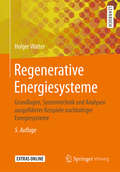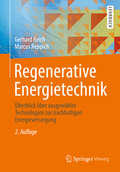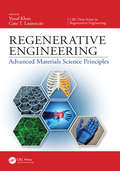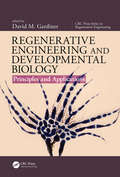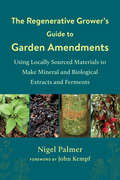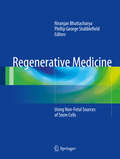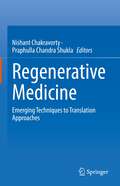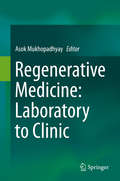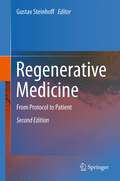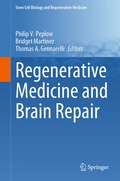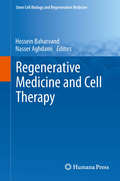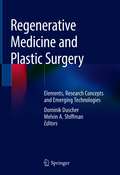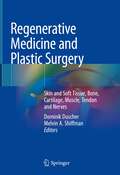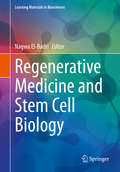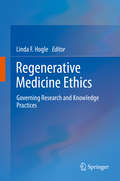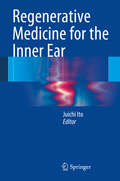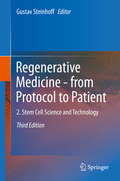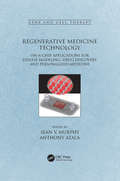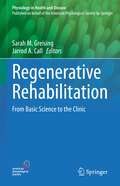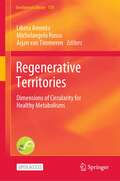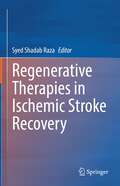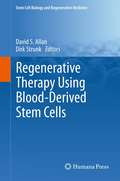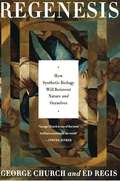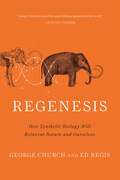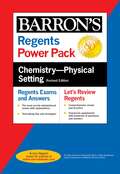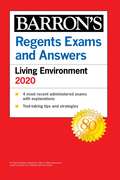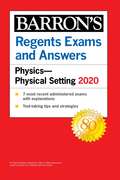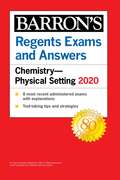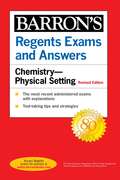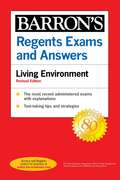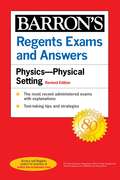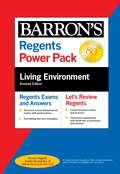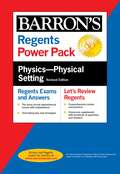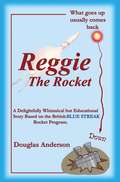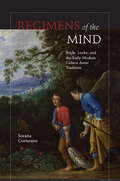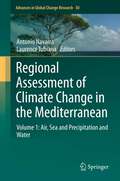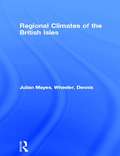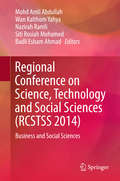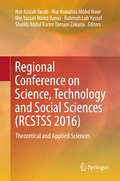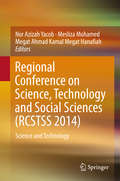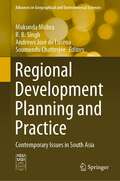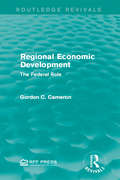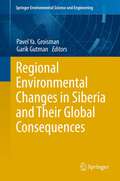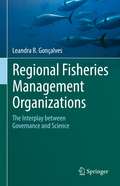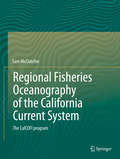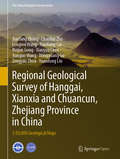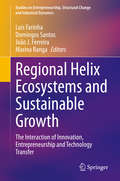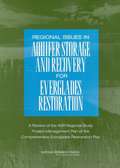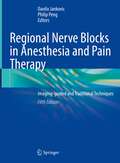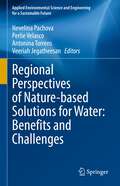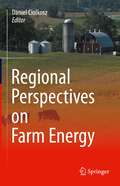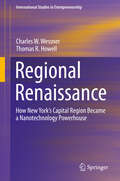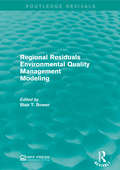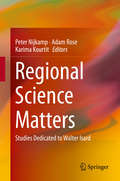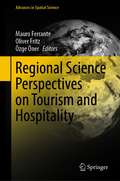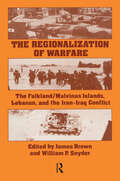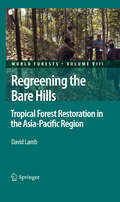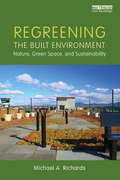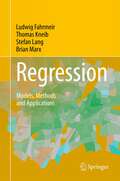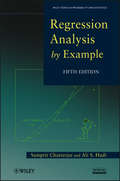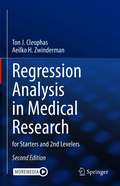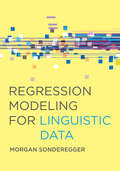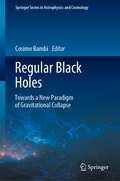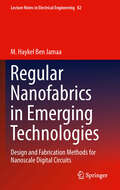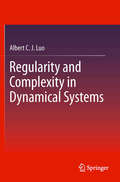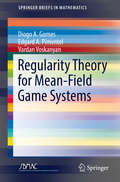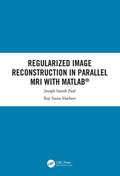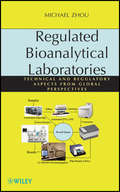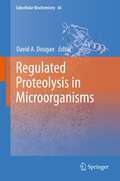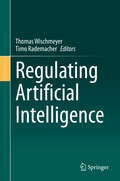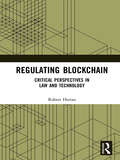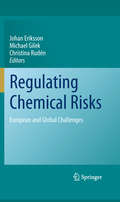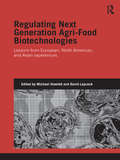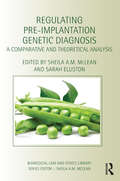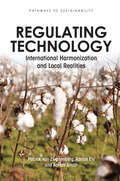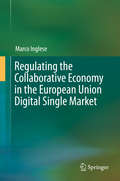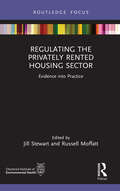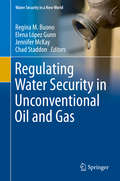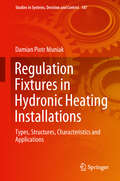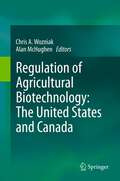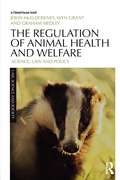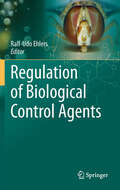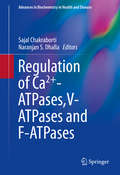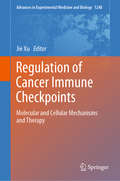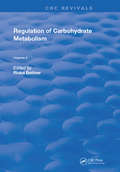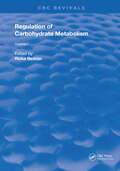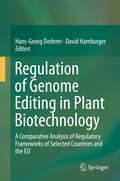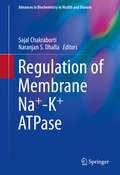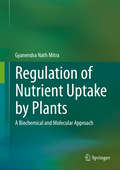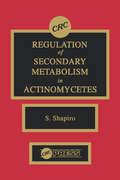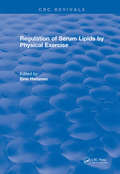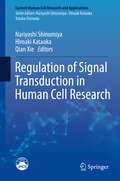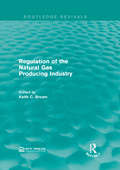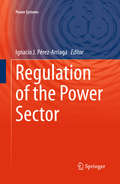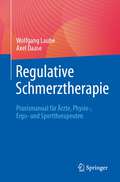- Table View
- List View
Regenerative Energiesysteme: Grundlagen, Systemtechnik und Analysen ausgeführter Beispiele nachhaltiger Energiesysteme
by Holger WatterErneuerbare Energien und nachhaltige Energiesysteme stehen auf Grund der Klimaveränderungen im Mittelpunkt der gesellschaftlichen Diskussion. Das Ziel dieses Lehrbuches ist es, wesentliche Funktionsmechanismen wichtiger nachhaltiger Energiesysteme darzustellen, Einflussparameter zu erläutern und Potentiale durch Überschlagsrechnungen aufzuzeigen. Beispielanlagen aus der Praxis geben zuverlässige Informationen für die tägliche Arbeit, dabei liegt der Schwerpunkt auf kleinen, dezentralen Anlagen. Übungen mit Lösungen erleichtern den Zugang zu den verschiedenen Stoffgebieten. Die 5. Auflage enthält aktualisierte volkswirtschaftliche Energie- und Leistungsdaten der verschiedenen Energiesektoren, neue Abbildungen zu Aufbau und Funktion von Wasserturbinen, eine Berechnungsmethode zur Abschätzung der adiabaten Temperatur für die thermo-chemische Umwandlung, Beschreibungen zu aktuellen Projektbeispielen für „Power-to-Gas" und „Power-to-Liquid" sowie eine Einführung in die Grundlagen des Projektmanagements im Energiesektor.
Regenerative Energietechnik: Überblick Über Ausgewählte Technologien Zur Nachhaltigen Energieversorgung
by Gerhard Reich Marcus ReppichDie Energiewirtschaft wird unter Berücksichtigung der Aspekte Versorgungssicherheit, Wirtschaftlichkeit sowie Klima- und Umweltschutz in den nächsten Jahrzehnten durch umfassende Veränderungen geprägt sein. Dieses Lehrbuch beschreibt Grundlagen ausgewählter Technologien zur Nutzung regenerativer Energiequellen, denen global langfristig das größte Potenzial eingeräumt wird. Den Schwerpunkt bildet die Umwandlung der Solarstrahlung und der Windenergie. Beide Technologien stellen unverzichtbare Bestandteile einer nachhaltigen Energieversorgung dar. Weiterhin werden die Erzeugung, die Speicherung und der Transport von Wasserstoff sowie Bauarten und Anwendungen von Brennstoffzellen erläutert. Beispielaufgaben und Übungen erleichtern und vertiefen das Verständnis.
Regenerative Engineering: Advanced Materials Science Principles (CRC Press Series In Regenerative Engineering)
by Yusuf Khan Cato T. LaurencinThis book focuses on advances made in both materials science and scaffold development techniques, paying close attention to the latest and state-of-the-art research. Chapters delve into a sweeping variety of specific materials categories, from composite materials to bioactive ceramics, exploring how these materials are specifically designed for regenerative engineering applications. Also included are unique chapters on biologically-derived scaffolding, along with 3D printing technology for regenerative engineering. Features: Covers the latest developments in advanced materials for regenerative engineering and medicine. Each chapter is written by world class researchers in various aspects of this medical technology. Provides unique coverage of biologically derived scaffolding. Includes separate chapter on how 3D printing technology is related to regenerative engineering. Includes extensive references at the end of each chapter to enhance further study.
Regenerative Engineering and Developmental Biology: Principles and Applications (CRC Press Series In Regenerative Engineering)
by David M. GardinerRegenerative Engineering and Developmental Biology: Principles and Applications examines cutting-edge developments in the field of regenerative engineering. Specific attention is given to activities that embrace the importance of integrating developmental biology and tissue engineering, and how this can move beyond repairing damage to body parts to instead regenerate tissues and organs. The text furthermore focusses on the five legs of the field of regenerative engineering, including: materials, developmental biology, stem cells, physics, and clinical translation. This book was written by leading developmental biologists; each chapter examines the processes that these biologists study and how they can be advanced by using the tools available in tissue engineering/biomaterials. Individual chapters are complete with concluding remarks and thoughts on the future of regenerative engineering. A list of references is also provided to aid the reader with further research. Ultimately, this book achieves two goals. The first encourages the biomedical community to think about how inducing regeneration is an engineering problem. The second goal highlights the discoveries with animal regeneration and how these processes can be engineered to regenerate body parts. Regenerative Engineering and Developmental Biology: Principles and Applications was written with undergraduate and graduate-level biomedical engineering students and biomedical professionals in mind.
The Regenerative Grower's Guide to Garden Amendments: Using Locally Sourced Materials to Make Mineral and Biological Extracts and Ferments
by Nigel PalmerRevitalize your garden—and go beyond compost—by making your own biologically diverse inoculants and mineral-rich amendments using leaf mold, weeds, eggshells, bones, and other materials available for little or no cost! In The Regenerative Grower’s Guide to Garden Amendments, experimental gardener and author Nigel Palmer provides practical, detailed instructions that are accessible to every grower who wants to achieve a truly sustainable garden ecosystem—all while enjoying better results at a fraction of the cost of commercial fertilizer products. These recipes go beyond fertilizer replacement, resulting in greater soil biological activity and mineral availability. They also increase pest and disease resistance, yields, and nutrient density. Recipes include: Extracting nutrients from plant residues using simple rainwater techniques Extracting minerals from bones and shells using vinegar Fermenting plant juices and fish Culturing indigenous microorganisms (IMO) Inspired by the work of many innovative traditional agricultural pioneers, especially Cho Ju-Young (founder of the Korean Natural Farming method), The Regenerative Grower’s Guide to Garden Amendments also includes a primer on plant-soil interaction, instructions for conducting a soil test, and guidance on compost, cover cropping, mulching, measuring the quality of fruits and vegetables using a refractometer, and other aspects of sustainable gardening—making it a must-have resource for any serious grower.
Regenerative Medicine
by Niranjan Bhattacharya Phillip George StubblefieldThis book represents a major contribution to the emerging science of regenerative medicine using non-fetal sources of stem cells. The Editors, Dr Niranjan Bhattacharya and Professor Phillip Stubblefield, have brought together some of the most pre-eminent scientists working on regenerative medicine to share information on currently ongoing work in this area alongside unpublished observations that will help to shape the contours of future therapies. Regenerative Medicine: Using Non-Fetal Sources of Stem Cells discusses the potential clinical and therapeutic applications using non-fetal stem cells as well as providing instruction on the collection, isolation and characterization of stem cells from various non-fetal sources, such as menstrual blood, adipose tissue, breast milk and uprooted decidual teeth. This book will be an invaluable resource for both active researches and those entering the field. The Editors truly hope that the text will act as a stimulant to professionals and clinical scientists, who may be inspired to further the work of the pioneering scientists who have contributed to this volume.
Regenerative Medicine: Emerging Techniques To Translation Approaches
by Nishant Chakravorty Praphulla Chandra ShuklaThis book focuses on the recent innovations and therapeutic potentials of regenerative medicine and discusses the applications of stem cells, biomaterials, and tissue engineering in regenerative medicine. The book covers essential aspects of regenerative medicine, including tissue microenvironment, immunological perspectives, stem, and non-stem cell-mediated approaches, imaging techniques, biomarkers, and 3D printing technology. It also reviews the applications of biosensing technologies in regenerative medicine, including biomanufacturing, organ-on-a-chip technologies, and as indicators of therapeutic efficacy. Further, it focuses on the regenerative medicine approaches for diseases of the central nervous system. It also provides the therapeutic potential of regenerative medicine to improve soft tissue and wound healing, cardiovascular, neural, bone, and orofacial regeneration.
Regenerative Medicine: Emerging Techniques to Translation Approaches
by Nishant Chakravorty Praphulla Chandra ShuklaThis book focuses on the recent innovations and therapeutic potentials of regenerative medicine and discusses the applications of stem cells, biomaterials, and tissue engineering in regenerative medicine. The book covers essential aspects of regenerative medicine, including tissue microenvironment, immunological perspectives, stem, and non-stem cell-mediated approaches, imaging techniques, biomarkers, and 3D printing technology. It also reviews the applications of biosensing technologies in regenerative medicine, including biomanufacturing, organ-on-a-chip technologies, and as indicators of therapeutic efficacy. Further, it focuses on the regenerative medicine approaches for diseases of the central nervous system. It also provides the therapeutic potential of regenerative medicine to improve soft tissue and wound healing, cardiovascular, neural, bone, and orofacial regeneration.
Regenerative Medicine: Laboratory to Clinic
by Asok MukhopadhyayThis book discusses the two different cellular approaches that are pursued in regenerative medicine: cell therapy and tissue engineering. It examines in detail the therapeutic application of hematopoietic stem cells in marrow regeneration, multi-potent mesenchymal stem cells (MSCs), also referred to as mesenchymal stromal cells. The interest in MSCs can be seen in more than 150 clinical trials, some of which have progressed to Phase III, despite the cells' limited differentiation potential. The book also explores how embryonic stem (ES) cells, being pluripotent in nature, can resolve some of the problems associated with adult stem cells, yet entail other challenges like risks of teratoma formation and immune rejection. A separate chapter deals with the role of noncoding RNAs in neuronal commitment of induced pluripotent stem (iPS) cells. Chapters like "Cord blood banking in India and the global scenario"; "3D bioprinting of tissue" and others will make this book an extremely interesting read for all students, researchers and clinicians working in the area of regenerative medicine/stem cells. The book is broadly divided into two parts, the first of which is devoted to basic information on stem cells, and the second of which addresses potential clinical applications in the areas of hematology, cardiology, orthopedic and immune suppression, etc.
Regenerative Medicine
by National Academies of Sciences EngineeringThe National Academies Press (NAP)--publisher for the National Academies--publishes more than 200 books a year offering the most authoritative views, definitive information, and groundbreaking recommendations on a wide range of topics in science, engineering, and health. Our books are unique in that they are authored by the nation's leading experts in every scientific field.
Regenerative Medicine
by Gustav SteinhoffRegenerative Medicine is a fastly emerging interdisciplinary field of research and clinical therapies on the repair, replacement or regeneration of cells, tissues or organs in congenital or acquired disease. This new field of research and clinical development focussing on stem cell science and regenerative biology is just starting to be the most fascinating and controversial medical development at the dawn of the 21st century. Viewing the great expectations to restructure and regenerate tissue, organs or organisms the current attempts of scientist and physicians are still in an early phase of development. This new textbook on "Regenerative Medicine - from protocol to patient" is aiming to explain the scientific knowledge and emerging technology as well as the clinical application in different organ systems and diseases. The international leading experts from four continents describe the latest scientific and clinical knowledge of the field of "Regenerative Medicine". The process of translating science of laboratory protocols into therapies is explained in sections on basic science, clinical translation, regulatory, ethical and industrial issues. The textbook is aiming to give the student, the researcher, the health care professional, the physician, and the patient a complete survey on the current scientific basis, therapeutical protocols, clinical translation and practised therapies in Regenerative Medicine.
Regenerative Medicine and Brain Repair (Stem Cell Biology and Regenerative Medicine #75)
by Philip V. Peplow Bridget Martinez Thomas A. GennarelliThis book presents the latest knowledge, trends, and advances in cell transplantation and innovations in developing microspheres, 3D biomaterial constructs to enhance transfer, and cell survival to specific regions of the brain. Neurodegenerative diseases and brain injury are increasing. Medications currently only temporarily reduce some of the symptoms but do not cure or delay progression of the disease. Development of effective treatments dramatically improves the independent living and quality of life of patients. Cell transplantation strategies offer an approach to facilitating brain repair, but efficacy is often limited by low in vivo survival rates of cells that are injected in suspension. Transplanting cells that are attached to or encapsulated within a biomaterial construct has the advantage of maintaining cell-cell and cell-material interactions and improving cell survival in vivo. Biomaterials that have been used in preclinical studies to assist with in vivo cell transfer and survival include heparin-chitosan microspheres, poly(lactic-co-glycolic acid) microspheres, RADA 16 microspheres, poly(desaminotyrosyl tyrosine ethyl ester carbonate) microscale scaffolds, carbon nanotubes, collagen-chitosan scaffolds, poly(L-lactic acid) scaffolds, agarose hydrogels, gelatin methacrylate hydrogels, and agarose micro-columns with an extracellular matrix interior. Incorporating growth factors (e.g., glial-derived neurotrophic factor, neurotrophin 3) into the biomaterial constructs increased cell survival and incorporation into the host tissue. International experts in the fields of both experimental and clinical neurological research contribute chapters to this book and discuss the latest achievements in cell transplantation and matrix-assisted cell transfer/survival technologies for diseases such as Alzheimer’s disease, Parkinson’s disease, and brain injuries such as stroke and traumatic brain injury. It is envisaged that research findings in experimental animal models of Alzheimer’s disease, Parkinson’s disease, traumatic brain injury, and stroke promote clinical trials using biomaterial-assisted transfer of cells.
Regenerative Medicine and Cell Therapy
by Nasser Aghdami Hossein BaharvandTherapeutic applications within regenerative biomedicine has gained tremendous interest from a growing, multidisciplinary community of investigators in recent years, driven by the hope of finding cures for several diseases. Regenerative Medicine and Cell Therapy discusses cutting-edge science in the field of regenerative biomedicine and its therapeutic applications to various medical disorders. The chapters are written by renowned scientists in the specific fields. This will be a useful book for basic and clinical scientists, especially young investigators and stem cell biology students who are newly entering the world of stem cells research. The editors' goal is that the new knowledge and research outlined in this book will help contribute to new therapies for a wide variety of diseases that presently afflict humanity.
Regenerative Medicine and Plastic Surgery: Elements, Research Concepts and Emerging Technologies
by Melvin A. Shiffman Dominik DuscherThis book discusses the current research concepts and the emerging technologies in the field of stem cells and tissue engineering. It is the first authoritative reference documenting all the ways that plastic surgical practice and regenerative medicine science overlap or provide a road map for the future of both specialties. The Editors have provided a valuable service by gathering in one place the leading voices in these two fields in clear and concise manner. Divided into five parts, the book opens with a description of the elements of regenerative medicine including definitions, basic principles of soft and bone tissue regeneration, biomaterials and scaffolds. Current research concepts are explored in the second part of this book, for example mechanotransduction and the utility of extracellular vesicles. In the third part, the editors present the emerging technologies and highlight the novel perspectives on bionic reconstruction and biomimetics in surgery and regenerative medicine. Part four deals with translational aspects including practical information on moving scientific findings from bench to bedside. The final part then describes in detail applications in clinical plastic surgery. Written by leading experts this book is an invaluable resource for researchers, students, beginners and experienced clinicians in a range of specialties."In your hands is a comprehensive encyclopedia of two rapidly converging fields. Drs Duscher and Shiffman have done an outstanding job of highlighting the interdependent relationship between plastic surgery and regenerative medicine. Ultimately, this is to the benefit of both fields." - Geoffrey C. Gurtner, MD, FACS Johnson and Johnson Distinguished Professor of Surgery Professor (by courtesy) of Bioengineering and Materials Science Inaugural Vice Chairman of Surgery for Innovation Stanford University School of Medicine
Regenerative Medicine and Plastic Surgery: Skin and Soft Tissue, Bone, Cartilage, Muscle, Tendon and Nerves
by Melvin A. Shiffman Dominik DuscherThis book presents the latest advances in the field of regenerative medicine in plastic surgery. It is the first authoritative reference documenting all the ways that plastic surgical practice and regenerative medicine science overlap or provide a road map for the future of both specialties. The Editors have provided a valuable service by gathering in one place the leading voices in these two fields in clear and concise manner.The first part introduces readers to essential principles of skin and soft tissue regeneration, e.g. the possibility of using mesenchymal stem cells for wound healing. Since bone serves as a supportive tissue in most of the body, bone regeneration is an important aspect of regenerative medicine; accordingly, the second part discusses the novel bone implants, activated bone grafts and bone tissue engineering. The book’s third part, focusing on cartilage regeneration, includes chapters on e.g. stem cells and ear regeneration. In turn, part four addresses muscle and tendon regeneration: from tendon to bone and tendon to muscle, as well as aging in the realm of muscle regeneration. Lastly, part five highlights nerve regeneration, deepening surgeons’ knowledge to help them successfully treat injuries to the peripheral neural system. Written by leading experts this book is an invaluable resource for researchers, students, beginners and experienced clinicians in a range of specialties."With beautiful clinical images and artwork, this book will be a central companion to both practicing plastic surgeons who wish to remain abreast of oncoming technologic advances and regenerative medicine researchers who wish to understand the current state of the art of surgical reconstruction." - Geoffrey C. Gurtner, MD, FACS Johnson and Johnson Distinguished Professor of Surgery Professor (by courtesy) of Bioengineering and Materials Science Inaugural Vice Chairman of Surgery for Innovation Stanford University School of Medicine
Regenerative Medicine and Stem Cell Biology: Bench To Bedside (Learning Materials in Biosciences #0)
by Nagwa El-BadriThis textbook covers the basic aspects of stem cell research and applications in regenerative medicine. Each chapter includes a didactic component and a practical section. The book offers readers insights into: How to identify the basic concepts of stem cell biology and the molecular regulation of pluripotency and stem cell development. How to produce induced pluripotent stem cells (iPSCs) and the basics of transfection. The biology of adult stem cells, with particular emphasis on mesenchymal stromal cells and hematopoietic stem cells, and the basic mechanisms that regulate them. How cancer stem cells arise and metastasize, and their properties. How to develop the skills needed to isolate, differentiate and characterize adult stem The clinical significance of stem cell research and the potential problems that need to be overcome. Evaluating the use of stem cells for tissue engineering and therapies (the amniotic membrane) The applications of bio-nanotechnology in stem cell research. How epigenetic mechanisms, including various DNA modifications and histone dynamics, are involved in regulating the potentiality and differentiation of stem cells. The scientific methods, ethical considerations and implications of stem cell research.
Regenerative Medicine Ethics
by Linda F. HogleThis book puts the ethics, policy and politics of stem cells into context in a way that helps readers understand why past and current issues have developed the way they have and what the implications are for their work going forward. It also addresses emerging issues as the field progresses towards clinical and industrial uses. While there is a superabundance of material on the ethics of embryo use and questions of embryonic "personhood," there is little that covers what practicing scientists and managers need to know in order to plan and execute responsible research. Furthermore, researchers funded by the NIH are required to have ethics training as a condition of the grant. As such, this book is an essential resource to all of these pre-professional students whether they plan to move into industry, government or academia.
Regenerative Medicine for the Inner Ear
by Juichi ItoThe research described in this book represents important steps toward understanding the development of inner ear medicine and new perspectives in regenerative medicine, including efficacy in cochlear implants and various other treatments. The book depicts the mechanisms that underlie inner ear diseases, their experimental models, and proposals for new strategies to treat their symptoms. As well, the exciting future prospects for dealing with the very common problem of inner ear diseases are explained. These disorders occur among many people and include sensorineural hearing loss (SNHL), sudden deafness, senile deafness, noise-induced deafness, tinnitus, dizziness-vertigo, and Ménière's disease. In Japan alone, there are more than 6 million deaf patients including those with middle-range deafness. There is currently no effective treatment, and regardless of the underlying cause, the damage has been considered irreversible. However, the results of recent research show that these patients actually can recover. The study of hair cells, spiral ganglion neurons, and stem cells for inner ear diseases such as SNHL, tinnitus, dizziness, and vertigo is at the forefront of regenerative medicine and may provide solutions to some of these problems. The information presented here makes this book a valuable professional reference work for all doctors and researchers in the field of otolaryngology who focus on regenerative treatments for inner ear diseases.
Regenerative Medicine - from Protocol to Patient
by Gustav SteinhoffRegenerative medicine is the main field of groundbreaking medical development and therapy using knowledge from developmental and stem cell biology as well as advanced molecular and cellular techniques. This collection of volumes, Regenerative Medicine: From Protocol to Patient, aims to explain the scientific knowledge and emerging technology as well as the clinical application in different organ systems and diseases. International leading experts from all over the world describe the latest scientific and clinical knowledge of the field of regenerative medicine. The process of translating science of laboratory protocols into therapies is explained in sections on regulatory, ethical and industrial issues. The collection is organized into five volumes: (1) Biology of Tissue Regeneration, (2) Stem Cell Science and Technology, (3) Tissue Engineering, Biomaterials and Nanotechnology, (4) Regenerative Therapies I, and (5) Regenerative Therapies II. The textbook gives the student, the researcher, the health care professional, the physician and the patient a complete survey on the current scientific basis, therapeutical protocols, clinical translation and practiced therapies in regenerative medicine. Volume 3: Tissue engineering, Biomaterials and Nanotechnology focuses the development of technologies, which enable an efficient transfer of therapeutic genes and drugs exclusively to target cells and potential bioactive materials for clinical use. Principles of tissue engineering, vector technology, multifunctionalized nanoparticles, biodegradable materials, controlled release, and biointerface technology are described with regard to the development of new clinical cell technology. Imaging and targeting technologies as well as biological aspects of tissue and organ engineering are depicted.
Regenerative Medicine Technology: On-a-Chip Applications for Disease Modeling, Drug Discovery and Personalized Medicine (Gene and Cell Therapy)
by Anthony Atala Sean V. MurphyMiniaturization in the fields of chemistry and molecular biology has resulted in the "lab-on-a-chip." Such systems are micro-fabricated devices capable of handling extremely small fluid volumes facilitating the scaling of single or multiple lab processes down to a microchip-sized format. The convergence of lab-on-a-chip technology with the field of cell biology facilitated the development of "organ-on-a-chip" systems. Such systems simulate the function of tissues and organs, having the potential to bypass some cell and animal testing methods. These technologies have generated high interest as applications for disease modeling and drug discovery. This book, edited by Drs. Sean Murphy and Anthony Atala, provides a comprehensive coverage of the technologies that have been used to develop organ-on-a-chip systems. Known leaders cover the basics to the most relevant and novel topics in the field, including micro-fabrication, 3D bio-printing, 3D cell culture techniques, biosensor design and microelectronics, micro-fluidics, data collection, and predictive analysis. The book describes specific tissue types amenable for disease modeling and drug discovery applications. Lung, liver, heart, skin and kidney "on-a-chip" technologies are included as well as a progress report on designing an entire "body-on-a-chip" system. Additionally, the book covers applications of various systems for modeling tissue-specific cancers, metastasis, and tumor microenvironments; and provides an overview of current and potential applications of these systems to disease modeling, toxicity testing, and individualized medicine.
Regenerative Pharmacology
by George J. Christ Karl-Erik AnderssonRegenerative medicine is broadly defined as the repair or replacement of damaged cells, tissues, and organs. It is a multidisciplinary effort in which technologies derive from the fields of cell, developmental, and molecular biology; chemical and material sciences (i. e. , nanotechnology); engineering; surgery; transplantation; immunology; molecular genetics; physiology; and pharmacology. As regenerative medicine technologies continue to evolve and expand across the boundaries of numerous scientific disciplines, they remain at the forefront of the translational research frontier with the potential to radically alter the treatment of a wide variety of disease and dysfunction. The goal of this book is to draw attention to the critical role that the pharmacological sciences will undeniably play in the advancement of these treatments. This book is invaluable for advanced students, postdoctoral fellows, researchers new to the field of regenerative medicine/tissue engineering, and experienced investigators looking for new research avenues. This is the first state-of-the-art book in this rapidly evolving field of research.
Regenerative Rehabilitation: From Basic Science to the Clinic (Physiology in Health and Disease)
by Sarah M. Greising Jarrod A. CallThis contributed volume presents the current state of research on regenerative rehabilitation across a broad range of neuro- and musculoskeletal tissues. At its core, the primary goal of regenerative rehabilitation is to restore function after damage to bones, skeletal muscles, cartilage, ligaments/tendons, or tissues of the central and peripheral nervous systems. The authors describe the physiology of these neuro- and musculoskeletal tissue types and their inherent plasticity. The latter quality is what enables these tissues to adapt to mechanical and/or chemical cues to improve functional capacity. As a result, readers will learn how regenerative rehabilitation exploits that quality, to trigger positive changes in tissue function. Combining basic, translational, and clinical aspects of the topic, the book offers a valuable resource for both scientists and clinicians in the regenerative rehabilitation field.
Regenerative Territories: Dimensions of Circularity for Healthy Metabolisms (GeoJournal Library #128)
by Libera Amenta Michelangelo Russo Arjan Van TimmerenThis open access book provides new perspectives on circular economy and space, explored towards the definition of regenerative territories characterised by healthy metabolisms. Going beyond the mere reuse/recycle of material waste as resources, this work aims to understand how to apply circularity principles to, among others, the regeneration of wastescapes. The main focus is the development over time, and in particular the way how spatial planning and strategies respond to new unpredictable urgencies and opportunities related with territorial metabolisms. The book specifically focuses on living labs environments, where it is possible to tackle complex problems through a multidisciplinary and multi-stakeholder approach - including the use of digital spatial decision support environment – which could be able to include all the involved stakeholders. Through a spatial scope of circularity, this book describes several examples including among others ideas from different contexts such as Italy, The Netherlands, Belgium and Vietnam. Through including reflections on methodology and representation, as well as on solutions for circular and healthy metabolisms, the book provides an excellent resource to researchers and students.
Regenerative Therapies in Ischemic Stroke Recovery
by Syed Shadab RazaThis book illustrates the importance and significance of regenerative medicine in stroke recovery. It discusses stem-cell-based treatment strategies and offers mechanistic insights into their role in neurological recovery. It also examines the challenges and advances in using adult stem cells for enhanced therapeutic efficacy. Further, it presents the strategies as well as the strengths and weaknesses of various delivery methods to administer stem cells in ischemic stroke. It examines the role of non-coding RNA in our understanding the stroke pathogenesis, their regulatory role in ischemic stroke and potential as biomarkers and therapeutic targets. Lastly, it explores exosomes in the treatment of stroke, and the underlying mechanism of their action as therapeutic vectors for stroke. Given its scope, it is an excellent resource for neurologists, neuroscientists and researchers involved in regenerative therapy for stroke.
Regenerative Therapy Using Blood-Derived Stem Cells
by David S. Allan Dirk StrunkBlood has long been viewed as a conduit for therapy, stemming from the ancient days of phlebotomy to remove evil humors to the development of successful blood transfusions to replace missing blood components. The identification and characterization of hematopoietic stem cells by Drs. Till and McCulloch revolutionized the field and soon after, non-hematopoietic stem and progenitor cells were characterized from the blood and bone marrow. Some of these cell types and various blood-derived cell lineages are involved in the repair of various types of tissue damage that span the spectrum of medical disorders. The goal of this book is to provide an up-to-date review of the various types of blood-derived cells with regenerative capacity, identify opportunities for intervention by examining specific clinical applications, and recognize the regulatory environment that will encompass future therapies in regenerative medicine.
Regenesis
by George Church Ed RegisEveryone has heard of genetic engineering: we eat engineered foods, we take drugs made in engineered bacteria and yeast, and someday soon may drive our cars on fuel produced by engineered microorganisms. "Regenesis" is the story of where these technologies came from, and where theyOCOre going, told by the man leading the revolution: Harvard genetics professor George Church. While traditional genetic engineering introduces changes to an organism a few genes at a time, genomic engineering introduces changes on a wholesale basis, allowing for unprecedented feats of synthetic biological engineering. (The technique, called MAGE, was invented by the author. ) In "Regenesis," Church argues for the great potential of this technology, not only to make existing organisms more useful, but for inventing wholly new speciesOCobacterial, animal, and human. It promises to be a strange future, with biohackers building organisms in their garages, companies manufacturing toolkits of DNA parts for creating living machines, and much else. Researchers have already managed to get microbes to produce jet fuel, gasoline, and electricity. And even vaccines, drugs, and industrial chemicals (OC green chemistryOCO). They can reprogram bacteria to metabolize greenhouse gases and convert them into harmless, even beneficial substances. Still, incredible as they might seem, these exploits are minor advances compared to the catalog of wonders that full-blown genomic engineering will make possible, from resurrecting woolly mammoths and other extinct organisms to creating mirror life forms immune to disease. The rise of synthetic biology marks a fundamental transformation in the relationship between biology and nature. When humans can control the genetic makeup of organisms to the extent foreseen by synthetic biologists, nature will no longer be the exclusive arbiter of life, death, and evolution. "Regenesis" reveals what this not so far off future will look like.
Regenesis: How Synthetic Biology Will Reinvent Nature and Ourselves
by George Church Ed RegisImagine a future in which human beings have become immune to all viruses, in which bacteria can custom-produce everyday items, like a drinking cup, or generate enough electricity to end oil dependency. Building a house would entail no more work than planting a seed in the ground. These scenarios may seem far-fetched, but pioneering geneticist George Church and science writer Ed Regis show that synthetic biology is bringing us ever closer to making such visions a reality. InRegenesis, Church and Regis explorethe possibilities--and perils--of the emerging field of synthetic biology. Synthetic biology, in which living organisms are selectively altered by modifying substantial portions of their genomes, allows for the creation of entirely new species of organisms. Until now, nature has been the exclusive arbiter of life, death, and evolution; with synthetic biology, we now have the potential to write our own biological future. Indeed, as Church and Regis show, iteven enables us to revisit crucial points in the evolution of life and, through synthetic biological techniques, choose different paths from those nature originally took. Such exploits will involve far more than just microbial tinkering. Full-blown genomic engineering will make possible incredible feats, from resurrecting woolly mammoths and other extinct organisms to creating mirror life forms with a molecular structure the opposite of our own. These technologies--far from the out-of-control nightmare depicted in science fiction--have the power to improve human and animal health, increase our intelligence, enhance our memory, and even extend our life span. A breathtaking look at the potential of this world-changing technology,Regenesisis nothing less than a guide to the future of life.
Regenesis: How Synthetic Biology Will Reinvent Nature and Ourselves
by Ed Regis George M. Church"Bold and provocative. . . Regenesis tells of recent advances that may soon yield endless supplies of renewable energy, increased longevity and the return of long-extinct species. ”--New Scientist In Regenesis, Harvard biologist George Church and science writer Ed Regis explore the possibilities--and perils--of the emerging field of synthetic biology. Synthetic biology, in which living organisms are selectively altered by modifying substantial portions of their genomes, allows for the creation of entirely new species of organisms. These technologies--far from the out-of-control nightmare depicted in science fiction--have the power to improve human and animal health, increase our intelligence, enhance our memory, and even extend our life span. A breathtaking look at the potential of this world-changing technology, Regenesis is nothing less than a guide to the future of life.
Regents Chemistry--Physical Setting Power Pack Revised Edition: The Physical Setting (Barron's Regents NY)
by Albert S. Tarendash M.S.Barron&’s two-book Regents Chemistry Power Pack provides comprehensive review, actual administered exams, and practice questions to help students prepare for the Chemistry Regents exam. All Regents test dates for 2020 have been canceled. Currently the State Education Department of New York has released tentative test dates for the 2021 Regents. The dates are set for January 26-29, 2021, June 15-25, 2021, and August 12-13th. This edition includes:Regents Exams and Answers: ChemistryEight actual administered Regents Chemistry exams so students can get familiar with the testThorough explanations for all answersSelf-analysis charts to help identify strengths and weaknessesTest-taking techniques and strategiesA detailed outline of all major topics tested on this examA glossary of important terms to know for test dayLet's Review Regents: ChemistryExtensive review of all topics on the testExtra practice questions with answersA detailed introduction to the Regents Chemistry course and examOne actual, recently released, Regents Chemistry exam with an answer keyThe Power Pack includes two volumes for a savings of $4.99.
Regents Exams and Answers: Living Environment 2020 (Barron's Regents)
by Gregory Scott HunterBarron’s Regents Exams and Answers: Living Environment 2020 provides essential review for students taking the Living Environment Regents, including actual exams administered for the course, thorough answer explanations, and comprehensive review of all topics. This edition features: Four actual Regents exams to help students get familiar with the test format, Comprehensive review questions grouped by topic, to help refresh skills learned in class, Thorough explanations for all answers, Score analysis charts to help identify strengths and weaknesses, Study tips and test-taking strategies. Looking for additional practice and review? Check out Barron’s Regents Living Environment Power Pack 2020 two-volume set, which includes Let’s Review Regents: Living Environment 2020 in addition to the Regents Exams and Answers: Living Environment 2020 book.
Regents Exams and Answers: Physics--Physical Setting 2020 (Barron's Regents)
by Miriam Lazar M.S. Ed.Barron’s Regents Exams and Answers: Physics 2020 provides essential review for students taking the Physics Regents, including actual exams administered for the course, thorough answer explanations, and comprehensive review of all topics. This edition features: Seven actual, administered Regents exams so students can get familiar with the test, Comprehensive review questions grouped by topic, to help refresh skills learned in class, Thorough explanations for all answers, Score analysis charts to help identify strengths and weaknesses, Study tips and test-taking strategies. Looking for additional practice and review? Check out Barron’s Regents Physics Power Pack 2020 two-volume set, which includes Let’s Review Regents: Physics 2020 in addition to the Regents Exams and Answers: Physics book.
Regents Exams and Answers: Chemistry--Physical Setting 2020 (Barron's Regents NY)
by Albert TarendashBarron’s Regents Exams and Answers: Chemistry 2020 provides essential practice for students taking the Chemistry Regents, including actual recently administered exams and thorough answer explanations for all questions. This book features: * Eight actual administered Regents Chemistry exams so students can get familiar with the test * Thorough explanations for all answers * Self-analysis charts to help identify strengths and weaknesses * Test-taking techniques and strategies * A detailed outline of all major topics tested on this exam * A glossary of important terms to know for test day Looking for additional practice and review? Check out Barron’s Regents Chemistry Power Pack 2020 two-volume set, which includes Let’s Review Regents: Chemistry 2020 in addition to the Regents Exams and Answers: Chemistry 2020 book.
Regents Exams and Answers: Chemistry--Physical Setting Revised Edition (Barron's Regents NY)
by Albert Tarendash M.S.Barron&’s Regents Exams and Answers: Chemistry provides essential practice for students taking the Chemistry Regents, including actual recently administered exams and thorough answer explanations for all questions. All Regents test dates for 2020 have been canceled. Currently the State Education Department of New York has released tentative test dates for the 2021 Regents. The dates are set for January 26-29, 2021, June 15-25, 2021, and August 12-13th. This book features:Eight actual administered Regents Chemistry exams so students can get familiar with the testThorough explanations for all answersSelf-analysis charts to help identify strengths and weaknessesTest-taking techniques and strategiesA detailed outline of all major topics tested on this examA glossary of important terms to know for test dayLooking for additional practice and review? Check out Barron&’s Regents Chemistry Power Pack two-volume set, which includes Let&’s Review Regents: Chemistry in addition to the Regents Exams and Answers: Chemistry book.
Regents Exams and Answers: Living Environment Revised Edition (Barron's Regents NY)
by Gregory Scott HunterBarron&’s Regents Exams and Answers: Living Environment provides essential review for students taking the Living Environment Regents, including actual exams administered for the course, thorough answer explanations, and comprehensive review of all topics. All Regents test dates for 2020 have been canceled. Currently the State Education Department of New York has released tentative test dates for the 2021 Regents. The dates are set for January 26-29, 2021, June 15-25, 2021, and August 12-13th. This edition features:Four actual Regents exams to help students get familiar with the test formatComprehensive review questions grouped by topic, to help refresh skills learned in classThorough explanations for all answersScore analysis charts to help identify strengths and weaknessesStudy tips and test-taking strategiesLooking for additional practice and review? Check out Barron&’s Regents Living Environment Power Pack two-volume set, which includes Let&’s Review Regents: Living Environment in addition to the Regents Exams and Answers: Living Environment book.
Regents Exams and Answers Physics Physical Setting Revised Edition (Barron's Regents NY)
by Miriam Lazar M.S. Ed.Barron&’s Regents Exams and Answers: Physics 2020 provides essential review for students taking the Physics Regents, including actual exams administered for the course, thorough answer explanations, and comprehensive review of all topics. All Regents test dates for 2020 have been canceled. Currently the State Education Department of New York has released tentative test dates for the 2021 Regents. The dates are set for January 26-29, 2021, June 15-25, 2021, and August 12-13th. This edition features:Eight actual, administered Regents exams so students can get familiar with the testComprehensive review questions grouped by topic, to help refresh skills learned in classThorough explanations for all answersScore analysis charts to help identify strengths and weaknessesStudy tips and test-taking strategiesLooking for additional practice and review? Check out Barron&’s Regents Physics Power Pack 2020 two-volume set, which includes Let&’s Review Regents: Physics 2020 in addition to the Regents Exams and Answers: Physics book.
Regents Living Environment Power Pack Revised Edition (Barron's Regents NY)
by Gregory Scott HunterBarron&’s two-book Regents Living Environment Power Pack provides comprehensive review, actual administered exams, and practice questions to help students prepare for the Biology Regents exam. All Regents test dates for 2020 have been canceled. Currently the State Education Department of New York has released tentative test dates for the 2021 Regents. The dates are set for January 26-29, 2021, June 15-25, 2021, and August 12-13th. This edition includes:Four actual Regents examsRegents Exams and Answers: Living EnvironmentFour actual, administered Regents exams so students can get familiar with the testComprehensive review questions grouped by topic, to help refresh skills learned in classThorough explanations for all answersScore analysis charts to help identify strengths and weaknessesStudy tips and test-taking strategiesLet's Review Regents: Living EnvironmentExtensive review of all topics on the testExtra practice questions with answersOne actual Regents examThe Power Pack includes two volumes for a savings of $4.99.
Regents Physics--Physical Setting Power Pack Revised Edition (Barron's Regents NY)
by Miriam A. Lazar M.S. Albert Tarendash M.S.Barron&’s Regents Physics Power Pack provides comprehensive review, actual administered exams, and practice questions to help students prepare for the Physics Regents exam. All Regents test dates for 2020 have been canceled. Currently the State Education Department of New York has released tentative test dates for the 2021 Regents. The dates are set for January 26-29, 2021, June 15-25, 2021, and August 12-13th. This edition includes:Two actual Regents exams onlineRegents Exams and Answers: Physics--Physical SettingFour actual, administered Regents exams so students have the practice they need to prepare for the testReview questions grouped by topic, to help refresh skills learned in classThorough explanations for all answersScore analysis charts to help identify strengths and weaknessesStudy tips and test-taking strategiesLet&’s Review Regents: Physics--Physical SettingComprehensive review of all topics on the testExtra practice questions with answersOne actual, administered Regents Physics exam with answer keyThe Power Pack includes two volumes for a savings of $4.99.
Reggie The Rocket: What Goes Up Usually Comes Back Down
by Douglas AndersonThe story of Reggie The Rocket closely tracks the history of the 1960s British Blue Streak rocket program. The author Douglas Anderson worked on the assembly and testing of the Rolls-Royce RZ2 engines powering the Blue Streak and was present in Woomera, Australia, for the launch of F3. Based on that experience, Douglas has assigned a personality to the rockets and has thus woven a whimsical element into an otherwise historical account of the Blue Streak Program. Reggie The Rocket is F3, the third in line to be launched, and Douglas was there to cheer him on. It is a sad reality that most heavy-lift booster rockets have been launched only to return to earth as scrap metal or to have disappeared into the ocean depths. Only now, fifty years after Blue Streak, are serious attempts being made to return booster rockets safely back to the launch pad under their own power so they can be reused. The days of 'throw away' rockets must surely come to an end if humans are to continue with orbital flights and deep space exploration.
Regimens of the Mind: Boyle, Locke, and the Early Modern Cultura Animi Tradition
by Sorana CorneanuIn Regimens of the Mind, Sorana Corneanu proposes a new approach to the epistemological and methodological doctrines of the leading experimental philosophers of seventeenth-century England, an approach that considers their often overlooked moral, psychological, and theological elements. Corneanu focuses on the views about the pursuit of knowledge in the writings of Robert Boyle and John Locke, as well as in those of several of their influences, including Francis Bacon and the early Royal Society virtuosi. She argues that their experimental programs of inquiry fulfill the role of regimens for curing, ordering, and educating the mind toward an ethical purpose, an idea she tracks back to the ancient tradition of cultura animi. Corneanu traces this idea through its early modern revival and illustrates how it organizes the experimental philosophers’ reflections on the discipline of judgment, the study of nature, and the study of Scripture. It is through this lens, the author suggests, that the core features of the early modern English experimental philosophy—including its defense of experience, its epistemic modesty, its communal nature, and its pursuit of “objectivity”—are best understood.
Regional Assessment of Climate Change in the Mediterranean
by Antonio Navarra Laurence TubianaThis is the third volume of a three-volume final report, which thoroughly describes, synthesizes and analyzes the results of the four-year Integrated Research Project CIRCE - Climate Change and Impact Research: Mediterranean Environment, funded by the EU 6th Framework Programme. Conducted under the auspices of the National Institute of Geophysics and Volcanology in Rome, Italy, the study was designed to predict and to quantify the physical impacts of climate change in the Mediterranean, and to assess the most influential consequences for the population of the region.
Regional Climates of the British Isles
by Julian Mayes Dennis WheelerGlobal climate and the effects of global warming are commanding unprecedented interest as climates grow more dynamic and changeable. How does global warming change patterns of climate? Why is the weather and climate of the British Isles so variable? Regional Climates of the British Isles presents a comprehensive and up-to-date survey of the diverse climate of the British Isles. <p><p> Examining the ways in which regional climates evolve from the interplay of meteorological conditions and geography of the British Isles, leading climatologists provide detailed explanations of the climatic characteristics of eleven regions of the British Isles. Climatic distinctiveness and local weather contrasts are described for each region, together with a summary of climatic data from 1961 to the present. <p> Reviewing the history and causes of climatic change and evaluating regional models, Regional Climates of the British Isles offers an important analysis of climatic variations. Examining future climatic change and its likely consequences, the authors acknowledge the need for regionally diverse responses to the greenhouse effect.
Regional Conference on Science, Technology and Social Sciences (RCSTSS #2014)
by Mohd Amli Abdullah Wan Kalthom Yahya Nazirah Ramli Siti Rosiah Mohamed Badli Esham AhmadThis book features more than 95 papers that were presented at the bi-annual Regional Conference on Science, Technology and Social Sciences, RCSTSS 2014, which was organized by Universiti Teknologi MARA Pahang. It covers topics ranging from communications studies, politics, psychology, education, religious studies as well as business and economics. The papers, which have been carefully reviewed, include research conducted by academicians locally, regionally and globally. They detail invaluable insights on the important roles played by the various disciplines in science, technology and social sciences. Coverage includes accounting, art and design, business, communication, economics, education, finance, humanity, information management, marketing, music, religion, social sciences and tourism. Throughout, clear illustrations, figures and diagrams complement the research. The book is a significant point of reference to academicians and students who want to pursue further research in their respective fields. It also serves as a platform to disseminate research findings as a catalyst to bring out positive innovations on the development of the region.
Regional Conference on Science, Technology and Social Sciences: Theoretical And Applied Sciences (RCSTSS #2016)
by Shaikh Abdul Karim Yamani Zakaria Rahmah Lob Yussof Nor Yuziah Mohd Yunus Nur Asmaliza Mohd Noor Nor Azizah YacobThis book gathers selected theoretical and applied science papers presented at the 2016 Regional Conference of Sciences, Technology and Social Sciences (RCSTSS 2016), organized biannually by the Universiti Teknologi MARA Pahang, Malaysia. Addressing a broad range of topics, including architecture, computer science, engineering, environmental and management, furniture, forestry, health and medicine, material science, mathematics, plantation and agrotechnology, sports science and statistics, the book serves as an essential platform for disseminating research findings, and inspires positive innovations in the region’s development.The carefully reviewed papers in this volume present work by researchers of local, regional and global prominence. Taken together, they offer a valuable reference guide and point of departure for all academics and students who want to pursue further research in their respective fields.
Regional Conference on Science, Technology and Social Sciences (RCSTSS #2014)
by Nor Azizah Yacob Mesliza Mohamed Megat Ahmad Kamal Megat HanafiahThis book gathers selected science and technology papers that were presented at the 2014 Regional Conference of Sciences, Technology and Social Sciences (RCSTSS 2014). The bi-annual Conference is organized by Universiti Teknologi MARA Pahang, Maylasia. The papers address a broad range of topics including architecture, life sciences, robotics, sustainable development, engineering, food science and mathematics. The book serves as a platform for disseminating research findings, as a catalyst to inspire positive innovations in the development of the region. The carefully-reviewed papers in this volume present research by academicians of local, regional and global prominence. Out of more than 200 manuscripts presented at the conference by researchers from local and foreign universities and institutions of higher learning, 64 papers were chosen for inclusion in this publication. The papers are organized in more than a dozen broad categories, spanning the range of scientific research: * Engineering * Robotics * Mathematics & Statistics * Computer & Information Technology * Forestry * Plantation & Agrotechnology * Sports Science & Recreation * Health & Medicine * Biology * Physics * Food Science * Environment Science & Management * Sustainable Development * Architecture The book provides a significant point of reference for academics, researchers and students in many fields who need deeper research.
Regional Development Planning and Practice: Contemporary Issues in South Asia (Advances in Geographical and Environmental Sciences)
by Mukunda Mishra R. B. Singh Andrews José de Lucena Soumendu ChatterjeeThis book, through a bunch of systematic and analytical notes and scientific commentaries, acquaints the readers with the innovative methods of regional development, measurement of the development in regional scale, regional development models, and policy prescriptions. Conceptualizing development as a regional process is a geographer's brainchild, and the sense of region has long been rooted deeply in the fundamental research practices that geographers are accustomed to. The geographical perspective of regions entails conceptualizing them nested horizontally as the formal region and hierarchical relationships in space with spatial flows or interactions as the functional region. In geographical research, the region works as a tool by serving as a statistical unit of analysis. More importantly, however, regions serve as the fundamental spatial units of management and planning by specifying a territory or a part of it for which a certain spatial development or regulatory plan is sought. This book addresses the complex processes in different regions of the world, particularly South Asia, to perceive the regional development planning involved and the sustainable management practiced there. The book is a useful resource for socio-economic planners, policymakers, and policy researchers.
Regional Economic Development: The Federal Role (Routledge Revivals)
by Gordon C. CameronFirst published in 1970, Regional Economic Development: The Federal Role examines the economic viability of depressed areas and regions. This book questions whether there is adequate justification, on national economic grounds, for Federal involvement with distressed area revitalisation and looks at the main guidelines for intervention in relation to typology of distressed areas. This title is an ideal resource for students interested in politics, macroeconomics, and federal policies concerning the revitalisation of distressed areas and economies.
Regional Environmental Changes in Siberia and Their Global Consequences
by Garik Gutman Pavel Ya. GroismanThis volume presents a state-of-the-art assessment of the Earth's climate system in Siberia and relationships between climate, ecosystems and people in that region. Changes in climatic variables and land cover in Siberia are among the earliest indicators of the Earth's response to climate warming. The volume is a compilation of results from studies on climate, land-cover and land-use changes and their interactions with biogeochemical and water cycles, atmospheric aerosol, and human and wildlife populations in Siberia. Regional changes in Siberia are predicted to affect climate and people on a global scale. NASA, the Russian Academy of Sciences, and several European institutions have supported these studies. The primary supporter of the projects that produced the results compiled in this volume is the NASA Land-Cover/Land-Use Change Program, hence most studies use remote sensing in their research. The chapters in this volume were written by an international team of scientists from the USA, Europe and Russia under the auspices of the Northern Eurasia Earth Science Partnership Initiative (NEESPI). This book will be of interest to those involved in studying recent and ongoing changes in Siberia, be they senior scientists, early career scientists or students.
Regional Fisheries Management Organizations: The interplay between governance and science
by Leandra R. GonçalvesThis book analyzes empirical data from three specific Regional Fisheries Management Organizations (RFMOs) designed to establish rules for the conservation and management of fish stocks in the ocean, in order to assess their effectiveness in converting science into policy for the recovery and maintenance of fishery populations. The three RFMOs discussed are the CCAMLR (Convention for the Conservation of Antarctic Marine Living Resources), the ICCAT (International Commission for the Conservation of Atlantic Tunas) and the CCSBT (Commission for the Conservation of Southern Bluefin Tuna). The book seeks to understand when governments choose to listen to science, and establishes a framework to examine the institutional designs currently in place to accommodate RFMO policy suggestions and the conditions under which they are implemented successfully. The study will be of interest to academics and professionals broadly interested in global environmental governance and international relations, and will specifically appeal to policymakers, conservationists, and environmental researchers interested in fishery management and policy at the global and regional scale. Gonçalves provides an accessible and comprehensive analysis of RMFOs. She offers valuable insights into the role of science and politics in shaping sustainable fisheries policies for the open oceans. ---Peter M Haas, Professor Department of Political Science, University of Massachusetts AmherstAs envisaged by the UN Decade of Ocean proclamation, this book is an important and sincere effort, hopefully to be accompanied by many others to come during this promising decade, that will help to build a common framework to ensure that ocean science can support countries and the international community in creating improved conditions for the sustainable development of our cherished Ocean.---Fabio H. Hazin - Professor at Federal Rural University of Pernambuco, Brazil
Regional Fisheries Oceanography of the California Current System
by Sam McclatchieThe California Current System is one of the best studied ocean regions of the world, and the level of oceanographic information available is perhaps only surpassed by the northeast and northwest Atlantic The current literature (later than 1993) offers no comprehensive, integrated review of the regional fisheries oceanography of the California Current System. This volume summarizes information of more than 60-year California Cooperative Oceanic Fisheries Investigation (CalCOFI) While providing a large bibliography, the intent was to extract themes relevant to current research rather than to prepare a compendious review of the literature The work presents a useful review and reference point for multidisciplinary fisheries scientists and biological oceanographers new to working in the California Current System, and to specialists wishing to access information outside their core areas of expertise. In addition it aims to deliver an up to date reference to the current state of knowledge of fisheries oceanography in the California Current System.
Regional Geological Survey of Hanggai, Xianxia and Chuancun, Zhejiang Province in China: 1:50,000 Geological Maps (The China Geological Survey Series)
by Jianfang Zhang Chaohui Zhu Longwu Wang Xiaoliang Cai Ruijun Gong Xiaoyou Chen Jianguo Wang Mingguang Gu Zongyao Zhou Yuandong LiuThis Open Access book introduces readers to the regional geology of Hanggai, Xianxia and Chuancun, the area between China's northern Zhejiang Province and southern Anhui Province and explores the strata, magmatic rocks and tectonic structures in 1:50,000 scale geological maps. Based on studies of multiple stratigraphic divisions, the standard stratigraphic section of the upper Ordovician Hirnantian in the lower Yangtze region is established, revealing for the first time numerous “Burgess Shale-type” sponge fossils in Hirnantian strata and identifying 10 grapholite fossil belts and various fossil categories, including chitin, trilobites, gastropods, brachiopods, and cephalopods. Moreover, the book identifies for the first time Late Ordovician volcanic events in northern Zhejiang province. The work represents a major contribution to research on Paleozoic strata in the Lower Yangtze region, and sheds new light on understanding the Hirnantian glacial event and biological extinction event in South China by providing a high-precision time scale. In addition, the book opens an important avenue for future research on sponge evolution after the Cambrian life explosion. As such, it offers a unique and valuable asset for researchers and graduate students alike.
Regional Helix Ecosystems and Sustainable Growth: The Interaction of Innovation, Entrepreneurship and Technology Transfer (Studies on Entrepreneurship, Structural Change and Industrial Dynamics)
by Luís Farinha Domingos Santos João J. Ferreira Marina RangaThis book discusses the importance of innovation and entrepreneurial ecosystems in supporting regional competitiveness. It also encourages academics, business professionals and policy-makers to rethink innovation ecosystems as drivers of regional competitiveness, demonstrating the complex interactions between regional economic and social actors, and their impact on regional competitiveness. Further, the book examines the role of entrepreneurship and innovation policies in different regions (e.g. lagging regions, rural regions, etc.), and describes critical success factors in multi-level technologies and innovation policies and strategies.
Regional Issues In Aquifer Storage And Recovery For Everglades Restoration
by Committee on Restoration of the Greater Everglades EcosystemThe report reviews a comprehensive research plan on Everglades restoration drafted by federal and Florida officials that assesses a central feature of the restoration: a proposal to drill more than 300 wells funneling up to 1. 7 billion gallons of water a day into underground aquifers, where it would be stored and then pumped back to the surface to replenish the Everglades during dry periods. The report says that the research plan goes a long way to providing information needed to settle remaining technical questions and clearly responds to suggestions offered by scientists in Florida and in a previous report by the Research Council.
Regional Nerve Blocks in Anesthesia and Pain Therapy: Imaging-guided and Traditional Techniques
by Danilo Jankovic Philip PengThis comprehensive atlas, which includes a wealth of illustrations and anatomic pictures created by the editors, covers a broad range of both regional anesthesia and pain intervention techniques, including neuromodulation. The book is unique in that it covers ultrasound and fluoroscopic-guided techniques, as well as traditional landmark-guided techniques. The authors and editors are internationally renowned experts, and share extensive theoretic and practical insights into regional anesthesia, pain therapy and anatomic sciences for everyday practice.The book addresses the application of ultrasound and fluoroscopic guidance for pain interventions and provides detailed coverage of ultrasound-guided and landmark-guided regional anesthesia. The book represents a detailed guide to the application of regional anesthesia and pain medicine; furthermore, examples of medico-legal documentation are also included in this edition. The 5th edition of Regional Nerve Blocks in Anesthesia and Pain Medicine is practically oriented and provides essential guidelines for the clinical application of regional anesthesia. It is intended for anesthesiologists and all professionals engaged in the field of pain therapy such as pain specialists, surgeons, orthopedists, neurosurgeons, neurologists, general practitioners, and nurse anesthetists.
Regional Perspectives of Nature-based Solutions for Water: Benefits and Challenges (Applied Environmental Science and Engineering for a Sustainable Future)
by Nevelina Pachova Perlie Velasco Antonina Torrens Veeriah JegatheesanNature-based solutions (NbS) are solutions inspired or supported by nature. They include ecosystem conservation and restoration measures, as well as the creation or enhancement of natural processes in man-made ecosystems, such as cities. Recent interest in NbS has emphasized their importance for urban water management and cities across the world have begun to experiment with them. Experiences from different contexts, however, are not adequately captured and understood. This book aims to address this gap by compiling case studies and reviews that explore NbS for urban water management from different regions and perspectives and highlight emerging challenges and opportunities for harnessing their potential.
Regional Perspectives on Farm Energy
by Daniel CiolkoszThis book examines the characteristics and opportunities for farm energy in the northeast quadrant of the United States, with attention to energy use, strategic energy management, and energy production by solar, wind, biomass, and other means. Throughout, the distinct characteristics of the region and their impact on energy solutions are discussed, and the outlook for future energy strategies is considered. Farm energy production and use are topics of increasing interest, as the need for improved efficiency and the opportunity for sustainable energy production both drive agricultural enterprises to reduce energy use and pursue opportunities for renewable energy production and use on the farm. However, the unique regional characteristics of agriculture make it challenging to apply a single approach to all situations.
Regional Renaissance: How New York’s Capital Region Became a Nanotechnology Powerhouse (International Studies in Entrepreneurship #42)
by Charles W. Wessner Thomas R. HowellThis book examines ways in which formerly prosperous regions can renew their economy during and after a period of industrial and economic recession. Using New York’s Capital Region (i.e., Albany, Troy, Schenectady, etc.) as a case study, the authors show how entrepreneurship, innovation, investment in education, research and political collaboration are critical to achieving regional success. In this way, the book provides other regions and nations with a real-life model for successful economic development. In the past half century, the United States and other nations have seen an economic decline of formerly prosperous regions as a result of new technology and globalization. One of the hardest-hit United States regions is Upstate New York or “the Capital Region”; it experienced a demoralizing hemorrhage of manufacturing companies, jobs and people to other regions and countries. To combat this, the region, with the help of state leaders, mounted a decades-long effort to renew and restore the region’s economy with a particular focus on nanotechnology. As a result, New York’s Capital Region successfully added thousands of well-paying, skill-intensive manufacturing jobs. New York’s success story serves as a model for economic development for policy makers that includes major public investments in educational institutions and research infrastructure; partnerships between academia, industry and government; and creation of frameworks for intra-regional collaboration by business, government, and academic actors. Featuring recommendations for best practices in regional development policy, this book is appropriate for scholars, students, researchers and policy makers in regional development, innovation, R&D policy, economic development and economic growth.
Regional Residuals Environmental Quality Management Modeling (Routledge Revivals)
by Blair T. BowerOriginally published in 1977, this title provides an overview of regional residuals-environmental quality management (REQM). Edited by Blair T. Bower, this volume offers insights on the analytical problems faced in developing useful information for societal decisions on REQM. It is a valuable resource for policy makers and students interested in environmental issues.
Regional Science Matters
by Peter Nijkamp Adam Rose Karima KourtitThis volume is a collection of fresh and novel contributions to regional science. They commemorate the scientific inheritance of the founding father of regional science, the late Walter Isard. All papers are written by well-known scholars in the field and serve to highlight the great importance of regional science theory and methodology for a better understanding of current spatial and environmental problems throughout our planet. The book showcases a multidisciplinary panorama of modern regional science research and presents new insights by applying regional science approaches.
Regional Science Perspectives on Tourism and Hospitality (Advances in Spatial Science)
by Mauro Ferrante Oliver Fritz Özge ÖnerThis book approaches the tourism and hospitality industry from a regional science perspective. By analyzing the spatial context of tourist travels, the hospitality sector, and the regional impacts of tourist activities, it demonstrates the value of the regional science paradigm for understanding the dynamics and effects of tourism and hospitality-related phenomena. Written by leading regional science scholars from various countries as well as professionals from organizations such as OECD and AirBnB, the contributions address topics such as migration, new types of accommodation, segmentation of tourism demand, and the potential use of tracking technologies in tourism research.The content is divided into five parts, the first of which analyzes spatial effects on the development of firms in the tourism industry, while the second approaches temporal and spatial variability in tourism through analytical regional science tools. The broader economic and social impacts of tourism are addressed in part three. Part four assesses specific tourism segments and tourist behaviors, while part five discusses environmental aspects and tourism destination policies. The book will appeal to scholars of regional and spatial science and tourism, as well as tourism specialists and policymakers interested in developing science and evidence-based tourism policies.
The Regionalization of Warfare: The Falkland/Malvinas Islands, Lebanon, and the Iran-Iraq Conflict
by James Brown William P. SnyderThree wars have dominated world events in recent years: The conflict which erupted between the United Kingdom and Argentina over the Falkland/Malvinas Islands; the multinational conflict in Lebanon involving Irsaeli, Syrian, and FLO forces in Lebanon; and the savage struggles between ground and air units of the Iranian and Iraqi forces. The scale and intensity of these wars, their potential for global conflict, make them crucial for an understanding among citizens in general, and defense and political analysts in particular.The authors and contributors to this most unusual volume come to several common conclusions: professionalism is a crucial factor in military effectiveness, but not necessarily dependent on modes of recruitment; high technology is crucial, but only in relation to the quality and training of the personnel; public support is necessary to sustain military morale in democratic and authoritarian regimes alike. These are only some of the incisive findings registered and explored in The Regionalization of Warfare.The volume a'ssembles experts not only on these three major regional and interregional conflicts, but on current U.S. defense policies; Soviet strategic interests in Middle East and Persian Gulf conflicts; and a series of papers on lessons learned and unlearned as a result of these "small wars" of the early 1980s. For those interested in military history, global strategy, and regional rivalries, this -collection of finely written, sophisticated papers will prove to be of intense concern.
Registered Health Information Technician (RHIT) Exam Preparation Sixth Edition
by Darcy Carter Patricia ShawConfidently prepare for the RHIT exam with Registered Health Information Technician (RHIT) Exam Preparation. The exam experience is simulated in this textbook with 850 multiple choice questions, including two complete practice exams based on the RHIT competency statements. Whether you're still learning or ready to test your skills immediately, RHIT Exam Preparation will help prepare you for exam day.
Regreening the Bare Hills
by David LambIn Regreening the Bare Hills: Tropical Forest Restoration in the Asia-Pacific Region, David Lamb explores how reforestation might be carried out both to conserve biological diversity and to improve the livelihoods of the rural poor. While both issues have attracted considerable attention in recent years, this book takes a significant step, by integrating ecological and silvicultural knowledge within the context of the social and economic issues that can determine the success or failure of tropical forest landscape restoration. Describing new approaches to the reforestation of degraded lands in the Asia-Pacific tropics, the book reviews current approaches to reforestation throughout the region, paying particular attention to those which incorporate native species - including in multi-species plantations. It presents case studies from across the Asia-Pacific region and discusses how the silvicultural methods needed to manage these 'new' plantations will differ from conventional methods. It also explores how reforestation might be made more attractive to smallholders and how trade-offs between production and conservation are most easily made at a landscape scale. The book concludes with a discussion of how future forest restoration may be affected by some current ecological and socio-economic trends now underway. The book represents a valuable resource for reforestation managers and policy makers wishing to promote these new silvicultural approaches, as well as for conservationists, development experts and researchers with an interest in forest restoration. Combining a theoretical-research perspective with practical aspects of restoration, the book will be equally valuable to practitioners and academics, while the lessons drawn from these discussions will have relevance elsewhere throughout the tropics.
Regreening the Built Environment: Nature, Green Space, and Sustainability
by Michael A RichardsRegreening the Built Environment examines the relationship between the built environment and nature and demonstrates how rethinking the role and design of infrastructure can environmentally, economically, and socially sustain the earth. In the past, infrastructure and green or park spaces have been regarded as two opposing factors and placed in conflict with one another through irresponsible patterns of development. This book attempts to change this paradigm and create a new notion that greenspace, parks, and infrastructure can indeed be one in the same. The case studies will demonstrate how existing "gray" infrastructure can be retrofitted with green infrastructure and low impact development techniques. It is quite plausible that a building can be designed that actually creates greenspace or generates energy; likewise, a roadway can be a park, an alley can be a wildlife corridor, and a parking surface can be a garden. In addition to examining sustainability in the near future, the book also explores such alternatives in the distant and very distant future, questioning the notion of sustainability in the event of an earth-altering, cataclysmic disaster. The strategies presented in this book aim to stimulate discussions within the design profession and will be of great interest to students and practitioners of environmental studies, architecture, and urban design.
Regression: Models, Methods and Applications
by Brian Marx Ludwig Fahrmeir Stefan Lang Thomas KneibThe aim of this book is an applied and unified introduction into parametric, non- and semiparametric regression that closes the gap between theory and application. The most important models and methods in regression are presented on a solid formal basis, and their appropriate application is shown through many real data examples and case studies. Availability of (user-friendly) software has been a major criterion for the methods selected and presented. Thus, the book primarily targets an audience that includes students, teachers and practitioners in social, economic, and life sciences, as well as students and teachers in statistics programs, and mathematicians and computer scientists with interests in statistical modeling and data analysis. It is written on an intermediate mathematical level and assumes only knowledge of basic probability, calculus, and statistics. The most important definitions and statements are concisely summarized in boxes. Two appendices describe required matrix algebra, as well as elements of probability calculus and statistical inference.
Regression Analysis by Example
by Samprit Chatterjee Ali S. HadiPraise for the Fourth Edition:"This book is . . . an excellent source of examples for regression analysis. It has been and still is readily readable and understandable."--Journal of the American Statistical Association Regression analysis is a conceptually simple method for investigating relationships among variables. Carrying out a successful application of regression analysis, however, requires a balance of theoretical results, empirical rules, and subjective judgment. Regression Analysis by Example, Fifth Edition has been expanded and thoroughly updated to reflect recent advances in the field. The emphasis continues to be on exploratory data analysis rather than statistical theory. The book offers in-depth treatment of regression diagnostics, transformation, multicollinearity, logistic regression, and robust regression.The book now includes a new chapter on the detection and correction of multicollinearity, while also showcasing the use of the discussed methods on newly added data sets from the fields of engineering, medicine, and business. The Fifth Edition also explores additional topics, including:Surrogate ridge regressionFitting nonlinear modelsErrors in variablesANOVA for designed experimentsMethods of regression analysis are clearly demonstrated, and examples containing the types of irregularities commonly encountered in the real world are provided. Each example isolates one or two techniques and features detailed discussions, the required assumptions, and the evaluated success of each technique. Additionally, methods described throughout the book can be carried out with most of the currently available statistical software packages, such as the software package R.Regression Analysis by Example, Fifth Edition is suitable for anyone with an understanding of elementary statistics.
Regression Analysis in Medical Research: for Starters and 2nd Levelers
by Ton J. Cleophas Aeilko H. ZwindermanRegression analysis of cause effect relationships is increasingly the core of medical and health research. This work is a 2nd edition of a 2017 pretty complete textbook and tutorial for students as well as recollection / update bench and help desk for professionals. It came to the authors' attention, that information of history, background, and purposes, of the regression methods addressed were scanty. Lacking information about all of that has now been entirely covered. The editorial art work of the first edition, however pretty, was less appreciated by some readerships, than were the original output sheets from the statistical programs as used. Therefore, the editorial art work has now been systematically replaced with original statistical software tables and graphs for the benefit of an improved usage and understanding of the methods. In the past few years, professionals have been flooded with big data. The Covid-19 pandemic gave cause for statistical software companies to foster novel analytic programs better accounting outliers and skewness. Novel fields of regression analysis adequate for such data, like sparse canonical regressions and quantile regressions, have been included.
Regression Modeling for Linguistic Data
by Morgan SondereggerThe first comprehensive textbook on regression modeling for linguistic data offers an incisive conceptual overview along with worked examples that teach practical skills for realistic data analysis.In the first comprehensive textbook on regression modeling for linguistic data in a frequentist framework, Morgan Sonderegger provides graduate students and researchers with an incisive conceptual overview along with worked examples that teach practical skills for realistic data analysis. The book features extensive treatment of mixed-effects regression models, the most widely used statistical method for analyzing linguistic data. Sonderegger begins with preliminaries to regression modeling: assumptions, inferential statistics, hypothesis testing, power, and other errors. He then covers regression models for non-clustered data: linear regression, model selection and validation, logistic regression, and applied topics such as contrast coding and nonlinear effects. The last three chapters discuss regression models for clustered data: linear and logistic mixed-effects models as well as model predictions, convergence, and model selection. The book&’s focused scope and practical emphasis will equip readers to implement these methods and understand how they are used in current work.The only advanced discussion of modeling for linguistsUses R throughout, in practical examples using real datasetsExtensive treatment of mixed-effects regression modelsContains detailed, clear guidance on reporting modelsEqual emphasis on observational data and data from controlled experimentsSuitable for graduate students and researchers with computational interests across linguistics and cognitive science
Regular Black Holes: Towards a New Paradigm of Gravitational Collapse (Springer Series in Astrophysics and Cosmology)
by Cosimo BambiBlack holes are one of the most fascinating predictions of general relativity. They are the natural product of the complete gravitational collapse of matter and today we have a body of observational evidence supporting the existence of black holes in the Universe. However, general relativity predicts that at the center of black holes there are spacetime singularities, where predictability is lost and standard physics breaks down. It is widely believed that spacetime singularities are a symptom of the limitations of general relativity and must be solved within a theory of quantum gravity. Since we do not have yet any mature and reliable candidate for a quantum gravity theory, researchers have studied toy-models of singularity-free black holes and of singularity-free gravitational collapses in order to explore possible implications of the yet unknown theory of quantum gravity. This book reviews all main models of regular black holes and non-singular gravitational collapses proposed in the literature, and discuss the theoretical and observational implications of these scenarios.
Regular Nanofabrics in Emerging Technologies
by M. Haykel Ben JamaaRegular Nanofabrics in Emerging Technologies gives a deep insight into both fabrication and design aspects of emerging semiconductor technologies, that represent potential candidates for the post-CMOS era. Its approach is unique, across different fields, and it offers a synergetic view for a public of different communities ranging from technologists, to circuit designers, and computer scientists. The book presents two technologies as potential candidates for future semiconductor devices and systems and it shows how fabrication issues can be addressed at the design level and vice versa. The reader either for academic or research purposes will find novel material that is explained carefully for both experts and non-initiated readers. Regular Nanofabrics in Emerging Technologies is a survey of post-CMOS technologies. It explains processing, circuit and system level design for people with various backgrounds.
Regularity and Complexity in Dynamical Systems
by Albert C. LuoRegularity and Complexity in Dynamical Systems describes periodic and chaotic behaviors in dynamical systems, including continuous, discrete, impulsive, discontinuous, and switching systems. In traditional analysis, the periodic and chaotic behaviors in continuous, nonlinear dynamical systems were extensively discussed even if unsolved. In recent years, there has been an increasing amount of interest in periodic and chaotic behaviors in discontinuous dynamical systems because such dynamical systems are prevalent in engineering. Usually, the smoothening of discontinuous dynamical system is adopted in order to use the theory of continuous dynamical systems. However, such technique cannot provide suitable results in such discontinuous systems. In this book, an alternative way is presented to discuss the periodic and chaotic behaviors in discontinuous dynamical systems.
Regularity Theory for Mean-Field Game Systems
by Diogo A. Gomes Edgard A. Pimentel Vardan VoskanyanBeginning with a concise introduction to the theory of mean-field games (MFGs), this book presents the key elements of the regularity theory for MFGs. It then introduces a series of techniques for well-posedness in the context of mean-field problems, including stationary and time-dependent MFGs, subquadratic and superquadratic MFG formulations, and distinct classes of mean-field couplings. It also explores stationary and time-dependent MFGs through a series of a-priori estimates for solutions of the Hamilton-Jacobi and Fokker-Planck equation. It shows sophisticated a-priori systems derived using a range of analytical techniques, and builds on previous results to explain classical solutions. The final chapter discusses the potential applications, models and natural extensions of MFGs. As MFGs connect common problems in pure mathematics, engineering, economics and data management, this book is a valuable resource for researchers and graduate students in these fields.
Regularized Image Reconstruction in Parallel MRI with MATLAB
by Joseph Suresh Paul Raji Susan MathewRegularization becomes an integral part of the reconstruction process in accelerated parallel magnetic resonance imaging (pMRI) due to the need for utilizing the most discriminative information in the form of parsimonious models to generate high quality images with reduced noise and artifacts. Apart from providing a detailed overview and implementation details of various pMRI reconstruction methods, Regularized image reconstruction in parallel MRI with MATLAB examples interprets regularized image reconstruction in pMRI as a means to effectively control the balance between two specific types of error signals to either improve the accuracy in estimation of missing samples, or speed up the estimation process. The first type corresponds to the modeling error between acquired and their estimated values. The second type arises due to the perturbation of k-space values in autocalibration methods or sparse approximation in the compressed sensing based reconstruction model. Features: Provides details for optimizing regularization parameters in each type of reconstruction. Presents comparison of regularization approaches for each type of pMRI reconstruction. Includes discussion of case studies using clinically acquired data. MATLAB codes are provided for each reconstruction type. Contains method-wise description of adapting regularization to optimize speed and accuracy. This book serves as a reference material for researchers and students involved in development of pMRI reconstruction methods. Industry practitioners concerned with how to apply regularization in pMRI reconstruction will find this book most useful.
Regulated Bioanalytical Laboratories
by Michael ZhouThis book provides useful information for bioanalytical / analytical scientists, analysts, quality assurance managers, and all personnel in bioanalytical laboratories through all aspects of bioanalytical technical and regulatory perspectives within bioanalytical operations and processes. Readers learn how to develop and implement strategies for routine, non-routine, and standard bioanalytical methods and on the entire equipment hardware and software qualification process. The book also gives guidelines on qualification of certified standards and in-house reference material as well as on people qualification. Finally, it guides readers through stressless internal and third party laboratory audits and inspections. It takes account to most national and international regulations and quality and accreditation standards, along with corresponding interpretation and inspection guides. The author elaborates on highly comprehensive content, making it easy not only to learn the subject but also to quickly implement the recommendations.
Regulated Proteolysis in Microorganisms
by David A. DouganThis book contains an extensive collection of critical reviews, from leading researchers in the field of regulated protein degradation. It covers the role of regulated proteolysis in a range of microorganisms (from Gram positive, Gram negative and pathogenic bacteria to Archaea and the Baker's yeast Saccharomyces cerevisiae).
Regulating Artificial Intelligence
by Thomas Wischmeyer Timo RademacherThis book assesses the normative and practical challenges for artificial intelligence (AI) regulation, offers comprehensive information on the laws that currently shape or restrict the design or use of AI, and develops policy recommendations for those areas in which regulation is most urgently needed. By gathering contributions from scholars who are experts in their respective fields of legal research, it demonstrates that AI regulation is not a specialized sub-discipline, but affects the entire legal system and thus concerns all lawyers. Machine learning-based technology, which lies at the heart of what is commonly referred to as AI, is increasingly being employed to make policy and business decisions with broad social impacts, and therefore runs the risk of causing wide-scale damage. At the same time, AI technology is becoming more and more complex and difficult to understand, making it harder to determine whether or not it is being used in accordance with the law. In light of this situation, even tech enthusiasts are calling for stricter regulation of AI. Legislators, too, are stepping in and have begun to pass AI laws, including the prohibition of automated decision-making systems in Article 22 of the General Data Protection Regulation, the New York City AI transparency bill, and the 2017 amendments to the German Cartel Act and German Administrative Procedure Act. While the belief that something needs to be done is widely shared, there is far less clarity about what exactly can or should be done, or what effective regulation might look like. The book is divided into two major parts, the first of which focuses on features common to most AI systems, and explores how they relate to the legal framework for data-driven technologies, which already exists in the form of (national and supra-national) constitutional law, EU data protection and competition law, and anti-discrimination law. In the second part, the book examines in detail a number of relevant sectors in which AI is increasingly shaping decision-making processes, ranging from the notorious social media and the legal, financial and healthcare industries, to fields like law enforcement and tax law, in which we can observe how regulation by AI is becoming a reality.
Regulating Blockchain: Critical Perspectives in Law and Technology
by Robert HerianAs the distributed architecture underpinning the initial Bitcoin anarcho-capitalist, libertarian project, 'blockchain' entered wider public imagination and vocabulary only very recently. Yet in a short space of time it has become more mainstream and synonymous with a spectacular variety of commercial and civic 'problem'/'solution' concepts and ideals. From commodity provenance, to electoral fraud prevention, to a wholesale decentralisation of power and the banishing of the exploitative practices of 'middlemen', blockchain stakeholders are nothing short of evangelical in their belief that it is a force for good. For these reasons and more the technology has captured the attention of entrepreneurs, venture capitalists, global corporations and governments the world over. Blockchain may indeed offer a unique technical opportunity to change cultures of transparency and trust within cyberspace, and as ‘revolutionary’ and ‘disruptive’ has the potential to shift global socioeconomic and political conventions. But as a yet largely unregulated, solutionist-driven phenomenon, blockchain exists squarely within the boundaries of capitalist logic and reason, fast becoming central to the business models of many sources of financial and political power the technology was specifically designed to undo, and increasingly allied to neoliberal strategies with scant regard for collective, political or democratic accountability in the public interest. Regulating Blockchain casts a critical eye over the technology, its ‘ecosystem’ of stakeholders, and offers a challenge to the prevailing discourse proclaiming it to be the great techno-social enabler of our times.
Regulating Chemical Risks
by Michael Gilek Christina Rudén Johan ErikssonThis important contribution to the scientific understanding of chemical risk regulation offers a coherent, comprehensive and updated multidisciplinary analysis, written by leading experts in toxicology, ecotoxicology, risk analysis, media and communication, law, and political science.
Regulating Next Generation Agri-Food Biotechnologies: Lessons from European, North American and Asian Experiences (Genetics and Society)
by Michael Howlett David LaycockAgri-food bio-technology policy and regulation is transitioning from an early period focused on genetic engineering technologies to ‘next-generation’ rules and regulatory processes linked to challenges originating in a wide variety of new technological processes and applications. Can lessons learned from past and current regulatory oversights of agricultural biotechnology – and other high-technology sectors – help us address new and emerging regulatory challenges in the agri-food genetics sector? The expert contributors in this volume discuss the experiences of a wide range of North American, European and Asian countries with high technology regulation to address four key questions related to the past and future development of agri-food genomics regulation across the globe. how unique is agri-food biotechology regulation, and how can it be evaluated using the existing tools of regulatory analysis developed in examinations of other sectors? is a ‘government to governance’ model of regulatory regime development found in many other sectors relevant in this rapidly evolving sphere of activity? is a stages model of regulatory regime development accurate? And, if so, at which stage are we currently positioned in the regulation of agri-food genomics products and technologies? what drives movement between stages in different countries and sectors? In assessing such drivers, what are the key links between sectoral (meso) developments and more general macro and micro developments such as international relations and administrative behaviour? By updating, extending and challenging earlier empirical and theoretical social science perspectives on agricultural bio-technological regulation, this volume helps to inform future policy formulation. It will be of interest to practitioners and students of biotechnology, agriculture, and science and technology policy, and regulatory processes more generally.
Regulating Pre-Implantation Genetic Diagnosis: A Comparative and Theoretical Analysis (Biomedical Law and Ethics Library)
by Sheila A.M. McLean Sarah EllistonThe successful achievement of pregnancies following pre-implantation genetic diagnosis (PGD) was first reported in April 1990. The technology is often used for patients who are at substantial risk of conceiving a pregnancy affected by a known genetic disorder, however from this technology other more controversial uses have arisen such as HLA typing to save the life of a sibling, gender selection for social reasons, the prevention of late onset diseases, or the prevention of diseases which may be genetically predisposed to developing such as breast cancer. The technology surrounding PGD is constantly developing, giving rise to new and unexpected consequences that create fresh ethical and legal dilemmas. Featuring internationally recognized experts in the field, this book critically explores the regulation of PGD and the broader legal and ethical issues associated with it. It looks at the regulatory situation in a number of jurisdictions including New Zealand, Australia and the United Kingdom, but it also explores a number of themes of wide significance including a historical consideration of PGD and its part in the creation of the "genetic embryo" as a political tool, the over regulation of PGD and the ethical difficulties in handling additional unexpected medical information yielded by new technologies. This book will be of particular interest to academics and students of law, medicine and ethics.
Regulating Technology: International Harmonization and Local Realities (Pathways to Sustainability)
by Patrick van Zwanenberg Adrian Ely Adrian SmithExamining the regulation of technologies, this book explores how the drive to harmonize regulatory policies across the world is at odds with the increasingly diverse local settings in which they are implemented. The authors use a 'framings' approach that starts with the concerns and experiences of technology users and works 'upwards' in order to examine how best to improve regulation. The book centres around two in-depth case study topics: regulation of transgenic cotton seed and regulation of antibiotics, compared across situations in China and Argentina. The authors examine how high-level initiatives in regulatory harmonization and regulatory capacity building compare with national policies, day-to-day enforcement realities on the ground, and with the way poorer users experience these technologies. Through these studies the authors offer ways to rethink regulation in order to realign the power and politics at play and create more effective regulation for technology users around the world. Published in association with the Economic and Social Research Council (ESRC).
Regulating the Collaborative Economy in the European Union Digital Single Market
by Marco IngleseThis book critically assesses how the rise of the collaborative economy in the European Union Digital Single Market is disrupting consolidated legal acquisitions, such as classical internal market categories, as well as the applicability of consumer protection, data protection, and labour and competition law. It argues that the collaborative economy will, sooner or later, require some sort of regulatory intervention from the European Union. This regulatory intervention, far from stifling innovation, will benefit online platforms, service providers and users by providing them with a clearer and more predictable environment in which to conduct their business. Although primarily intended for academics, this book also appeals to a wider readership, including, but not limited to, national and international regulators, private firms and lobbies as well as online platforms, consumer associations and trade unions.
Regulating the Privately Rented Housing Sector: Evidence into Practice (Routledge Focus on Environmental Health)
by Jill Stewart Russell MoffattThis book explores theory and practice in the complex policy area of privately rented housing in England, with a particular focus on environmental and public health. Bringing together a range of both academic and practicing experts in the field, it responds to the rapid growth and changing nature of the sector and considers the range of options available to local authorities in ensuring more effective regulation strategies. This book: Creates a key, up-to-date professional resource for housing regulation based on road-tested academic course material. Breaks down strategies and practices to an implementational level. Provides impetus to leaders, practitioners, and students to both deliver and reflect on improved regulation. Explores responses to various stakeholder needs through the lens of protecting and supporting tenants. This book will interest professionals working in public health, housing, and local authorities, as well as environmental health and housing academia. Students across environmental health, social work, nursing, and other disciplines will also find this appealing.
Regulating Water Security in Unconventional Oil and Gas (Water Security in a New World)
by Regina M. Buono Elena López Gunn Jennifer McKay Chad StaddonThis book addresses the need for deeper understanding of regulatory and policy regimes around the world in relation to the use of water for the production of ‘unconventional’ hydrocarbons, including shale gas, coal bed methane and tight oil, through hydraulic fracturing. Legal, policy, political and regulatory issues surrounding the use of water for hydraulic fracturing are present at every stage of operations. Operators and regulators must understand the legal, political and hydrological contexts of their surroundings, procure water for use in the fracturing and extraction processes, gain community cooperation or confront social resistance around water, collect flow back and produced water, and dispose of these wastewaters safely. By analysing and comparing different approaches to these issues from around the globe, this volume gleans insights into how policy, best practices and regulation may be developed to advance the interests of all stakeholders. While it is not always possible to easily transfer ‘good practice’ from one place to another, there is value in examining and understanding the components of different legal and regulatory regimes, as these may assist in the development of better regulatory law and policy for the rapidly growing unconventional energy sector.The book takes an interdisciplinary approach and includes chapters looking at water-energy nexus security in general, along with issue-focused and geographically-focused case studies written by scholars from around the world.Chapter topics, organized in conjunction with the stage of the shale gas production process upon which they touch, include the implications of hydraulic fracturing for agriculture, municipalities, and other stakeholders competing for water supplies; public opinion regarding use of water for hydraulic fracturing; potential conflicts between hydraulic fracturing and water as a human right; prevention of induced seismic activity, and the disposal or recycling of produced water. Several chapters also discuss implications of unconventional energy production for indigenous communities, particularly as regards sustainable water management. This volume will be of interest to scholars and students of energy and water, regulators and policymakers and operators interested in ensuring that they align with emergent best global practice.
Regulation Fixtures in Hydronic Heating Installations: Types, Structures, Characteristics and Applications (Studies in Systems, Decision and Control #187)
by Damian Piotr MuniakThe book focuses on design and computational issues related to fixtures and armatures in hydronic heating installations, especially regulation valves, their selection, operating principles, types and construction. The analysis is complemented by connection diagrams, drawings, photos of the valves and computational examples of their selection and operation parameters when used in a pipework and a controlled object, like a radiator. It also discusses issues related to the so-called valve authority, one of the main parameters determining the quality of the valve regulation process. Further, it includes an extensive theoretical framework along with a detailed mathematical analysis and proposes new algorithms, which have been verified and confirmed experimentally. Based on this analysis, the book presents the author’s analytical approach for sizing a regulation valve, as well as an innovative design solution for a regulation valve without the limitations of the valves currently available on the market. Lastly, it introduces a new verified method of calculating the valve pre-setting. Intended for engineers dealing with heating issues, scientists and students studying environmental engineering, energetics and related fields, the book is also useful for lecturers, designers, and those operating heating installations, as well as authors of computer programs for thermal and hydraulic balancing of heating installations.
Regulation of Agricultural Biotechnology: The United States and Canada
by Chris A. Wozniak Alan MchughenAgricultural biotechnology takes many forms and applications, with the number and diversity of products ever increasing. With this rapid development, regulatory authorities have sought to keep pace through regulatory adjustments and advances to ensure the safe and beneficial use of this critical technology. The regulatory systems for the U.S. and Canada are not static and must evolve in order to maintain relevance, efficiency and applicability to the challenges encountered. The diverse authors, drawn from the biotechnology industry, academia, government research and regulatory agencies, offer their perspectives of the historical and current system and suggest where it can be improved in the future. Based upon vast experience interacting with the regulatory system, the editors and authors offer demystifying views of the US and Canadian regulatory structures and how they came to be. We know of no other effort to present the biotechnology regulatory systems of the US and Canada in an open forum which will benefit those in the regulated community as well as those charged with oversight of the products of biotechnology, and ultimately the consumer!
The Regulation of Animal Health and Welfare: Science, Law and Policy (Law, Science and Society)
by John McEldowney Wyn Grant Graham MedleyThe Regulation of Animal Health and Welfare draws on the research of scientists, lawyers, economists and political scientists to address the current and future regulatory problems posed by the issues of animal health and disease. Recent events such as the outbreak of mad cow disease, epidemics of foot and mouth disease, concerns about bluetongue in sheep, and the entry into the food chain of the offspring of cloned cattle, have heightened awareness of the issues of regulation in animal disease and welfare. This book critically appraises the existing regulatory institutions and guiding principles of how best to maintain animal health in the context of social change and a developing global economy. Addressing considerations of sound science, the role of risk management, and the allocation of responsibilities, it also takes up the theoretical and practical challenges which here – and elsewhere – attend the co-operation of scientists, social scientists, lawyers and policy makers. Indeed, the collaboration of scientists and social scientists in determined and regulatory contexts such as that of animal disease is an issue of ever-increasing importance. This book will be of considerable value to those with interests in this issue, as well as those concerned with the law and policy relating to animal health and welfare.
Regulation of Biological Control Agents
by Ralf-Udo EhlersThis book presents a comprehensive compilation of registration requirements necessary for authorisation of biological control agents (viruses, bacteria, fungi, active substances of natural origin and semiochemicals) in OECD countries. It also reviews data requirements for invertebrate agents (insect, mites and nematodes) and provides proposals for harmonisation of the regulation process and guidelines for completion of application forms. Based on results of the EU REBECA Policy Support Action, which gathered experts from academia, regulation authorities and industry, risks and benefits of the specific agents were reviewed and proposals for a more balanced registration process elaborated, including recommendations for acceleration of the authorisation process and discussions on trade-off effects and policy impacts. All these aspects are covered in detail in this book, which points the way forward for enhanced utilisation of biological control agents.
Regulation of Ca2+-ATPases,V-ATPases and F-ATPases
by Naranjan S. Dhalla Sajal ChakrabortiThe biological membranes of cellular organization enfold an important group of membrane proteins called the ATPases, which are not only versatile in maintaining chemical gradient and electrical potential across the membrane but also bring metabolites necessary for cell metabolism and drive out toxins, waste products and solutes that otherwise can curb cell functions. ATPases are distributed virtually in all live forms starting from unicellular to multicellular and also in viruses. There are different types of ATPases, which differ in function and structure and in the type of ions they transport. The three main types of the ion pump ATPase family are: (i) P-type ATPases that transport different ions across membranes and Ca2+ATPases belongs to this catagory (ii) F-type ATPase in mitochondria, chloroplasts and bacterial plasma membranes produce ATP using the proton gradient; and (iii) V-type ATPase catalyzes ATP hydrolysis to transport solutes and maintains acidic pH in organelles like lysosomes. Genetic defects in either of the ATPases cause several diseases and a number of researches have demonstrated the involvement of the members of ATPases in the cell pathology and diseases, thereby penetrating exciting new areas of our understanding. In this book, the authors summarize recent knowledge about the molecular mechanisms associated with Ca2+-ATPase, V-ATPase and F-ATPase in intracellular and extracellular Ca2+ transport, mitochondrial ATP synthase, vesicular H+ transport, and lysosomal pH regulation. This book thereby bridges the gap between fundamental research and biomedical and pharmaceutical applications. The book provides an informative resource to improve ATPase research and modern therapeutic approaches toward different life threatening diseases that are associated with dysregulation of the ATPases.
Regulation of Cancer Immune Checkpoints: Molecular and Cellular Mechanisms and Therapy (Advances in Experimental Medicine and Biology #1248)
by Jie XuThis book systematically reviews the most important findings on cancer immune checkpoints, sharing essential insights into this rapidly evolving yet largely unexplored research topic. The past decade has seen major advances in cancer immune checkpoint therapy, which has demonstrated impressive clinical benefits. The family of checkpoints for mediating cancer immune evasion now includes CTLA-4, PD-1/PD-L1, CD27/CD70, FGL-1/LAG-3, Siglec-15, VISTA (PD-1L)/VSIG3, CD47/SIRPA, APOE/LILRB4, TIGIT, and many others. Despite these strides, most patients do not show lasting remission, and some cancers have been completely resistant to the therapy. The potentially lethal adverse effects of checkpoint blockade represent another major challenge, the mechanisms of which remain poorly understood. Compared to the cancer signaling pathways, such as p53 and Ras, mechanistic studies on immune checkpoint pathways are still in their infancy. To improve the responses to checkpoint blockade therapy and limit the adverse effects, it is essential to understand the molecular regulation of checkpoint molecules in both malignant and healthy cells/tissues. This book begins with an introduction to immune checkpoint therapy and its challenges, and subsequently describes the regulation of checkpoints at different levels. In closing, it discusses recent therapeutic developments based on mechanistic findings, and outlines goals for future translational studies. The book offers a valuable resource for researchers in the cancer immunotherapy field, helping to form a roadmap for checkpoint regulation and develop safer and more effective immunotherapies.
Regulation Of Carbohydrate Metabolism: Volume II
by Rivka BeitnerThis text comprises of two volumes discussing the regulation of carbohydrate metabolism.
Regulation of Carbohydrate Metabolism(1985): Volume I
by BeitnerFirst Published in 1985. A collaboration of the latest research on regulation of carbohydrate metabolism.
Regulation of Genome Editing in Plant Biotechnology: A Comparative Analysis of Regulatory Frameworks of Selected Countries and the EU
by Hans-Georg Dederer David HamburgerThis book provides in-depth insights into the regulatory frameworks of five countries and the EU concerning the regulation of genome edited plants. The country reports form the basis for a comparative analysis of the various national regulations governing genetically modified organisms (GMOs) in general and genome edited plants in particular, as well as the underlying regulatory approaches.The reports, which focus on the regulatory status quo of genome edited plants in Argentina, Australia, Canada, the EU, Japan and the USA, were written by distinguished experts following a uniform structure. On this basis, the legal frameworks are compared in order to foster a rational assessment of which approaches could be drawn upon to adjust, or to completely realign, the current EU regime for GMOs. In addition, a separate chapter identifies potential best practices for the regulation of plants derived from genome editing.
Regulation of Membrane Na+-K+ ATPase
by Naranjan S. Dhalla Sajal ChakrabortiNa+-K+ ATPase or Na-pump ATPase, a member of "P"-type ATPase superfamily, is characterized by association of multiple isoforms mainly of it's α- and β- subunits. At present four different α- (α-1,α-2,α-3 and α-4) and three β- (β-1, β-2, and β-3) isoforms have been identified in mammalian cells and their differential expressions are tissue specific. Regulation of Na+-K+ ATPase activity is an important but a complex process, which involves short-term and long-term mechanisms. Short-term regulation of Na+-K+ ATPase is either mediated by changes in intracellular Na+ concentrations that directly affect the Na+-pump activity or by phosphorylation/dephosphorylation-mediated by some stimulants leading to changes in its expression and transport properties. On the other hand, long-term regulation of Na+-K+ ATPase is mediated by hormones, such as mineralocorticoids and thyroid hormones, which cause changes in the transcription of genes of α- and β- subunits leading to an increased expression in the level of Na+-pump. Several studies have revealed a relatively new type of regulation that involves the association of small, single span membrane proteins with this enzyme. These proteins belong to the FXYD family, the members of which share a common signature sequence encompassing the transmembra ne domain adjacent to the isoform(s) of α-β subunits of Na+-K+ ATPase. Considering the extraordinary importance of Na+-K+ ATPase in cellular function, several internationally established investigators have contributed their articles in the monograph entitled "Regulation of Membrane Na+-K+ ATPase" for inspiring young scientists and graduate students to enrich their knowledge on the enzyme, and we are sure that this book will soon be considered as a comprehensive scientific literature in the area of Na+-K+ ATPase regulation in health and disease.
Regulation of Nutrient Uptake by Plants
by Gyanendra Nath MitraThis book describes the mechanisms of nutrient taken up by plants at the biochemical and molecular level. This is a new concept developed over the past 30 years, primarily due to use of modern technology developed in biotechnological research, instrumentation, modern computation facilities, bioinformatics, the large volumes of information generated by use of various 'omics' and of course the dedicated hard work of a large number of researchers. Recent research indicates that nutrient uptake, its transport and redistribution in plants are under genetic control. There are groups of genes for each nutrient that encode transporter proteins whose functions are to acquire the specific nutrient from the soil and transport it across the plasma membrane of the root hair cells for use in plant metabolism. Deficiency or sufficiency of a plant nutrient induces different groups of genes to produce m-RNA transcripts for translation of transporter proteins. A large number of metabolic enzymes are up or down regulated in response to deficiency of plant nutrients. Morphological and metabolic adaptations in order to better acquire nutrients and use them frugally when nutrients are scarce in the growth medium can be observed in plants. Heavy metals, which are toxic to plants, induce different sets of defence mechanisms. In 20 chapters, the book describes plants' uptake mechanisms for all the major, secondary and micronutrients, beneficial elements and heavy metals. References to research work quoted in the text are updated up to 2014 and included at the end of each chapter. Biotechnological approaches to improving nutrient use efficiency are discussed wherever such information is available. The structure and functions of transporter proteins involved in the uptake of nutrients are discussed. Additional information on some of the specific topics is provided in text boxes or as separate sections within the chapters. Lastly, the terminology used has been explained as far as possible in the text, mostly within parentheses.
Regulation of Secondary Metabolism in Actinomycetes
by Stuart ShapiroThis book provides a comprehensive examination of biochemical and genetic regulatory phenomena as they relate to the activity of actinomycete secondary metabolic pathways and the functioning of secondary metabolites as endogenous effectors of cytodifferentiation. Approximately 50 illustrations accompany the text.
Regulation Of Serum Lipids By Physical Exercise
by HietanenThe aim of this book is to concentrate on the role of physical training in the regulation of serum lipids in healthy man. This book will try to estimate the power of regular exercise and the intensity of exercise in the regulation of plasma lipid and lipoprotein concentrations, with the ultimate goal being to find out the basic mechanisms which mediate the exercise-induced changes in serum lipid profile.
Regulation of Signal Transduction in Human Cell Research (Current Human Cell Research and Applications)
by Qian Xie Hiroaki Kataoka Nariyoshi ShinomiyaThis volume focuses on the relationship between the regulation of signal transduction and disease mechanisms, and discusses how the dysregulation of intracellular signals cause diseases, cell death, carcinogenesis, and other disorders. Growth, survival, transformation, and metabolic activities at the cellular level are regulated by various intracellular signal transduction pathways. Sources that stimulate intracellular signals include intracellular stresses and signal regulators/modulators, as well as extracellular growth factors. Recent studies on signal transduction analysis using animal and human cell lines have revealed how the intracellular signals are regulated and why their dysregulation leads to pathological states such as tumorigenesis, metabolic diseases, cell death, and so on. This book highlights several important key molecules and intracellular signaling pathways such as microRNA, the TGF-beta signaling pathway, the Wnt signaling pathway and MET signaling pathway as topical and highly relevant issues in human cell research related to signal transduction. In addition to assessing the pathogenic role of these signaling pathways, it focuses on the molecular design of small molecule regulators/inhibitors of said pathways, one of the most important approaches in this area. This book offers a valuable guide, helping not only research scientists but also clinicians to understand how the dysregulation of intracellular signals leads to diseases.
Regulation of the Natural Gas Producing Industry (Routledge Revivals)
by Keith C. BrownOriginally published in 1972, Regulation of the Natural Gas Producing Industry combines several papers prepared for a seminar in Washington D.C in 1970.The purpose of this seminar was to exchange views between specialists on the issues related to regulation natural gas production. As such these papers explore issues such as producer price regulations, arguments for and against the regulation of natural gas, the changing environment of natural gas supply and what the future holds in terms of the natural gas producing industry. This title will be of interest to students of Environmental Studies and policy makers.
Regulation of the Power Sector
by Ignacio J. Pérez-ArriagaRegulation of the Power Sector is a unified, consistent and comprehensive treatment of the theories and practicalities of regulation in modern power-supply systems. The need for generation to occur at the time of use occasioned by the impracticality of large-scale electricity storage coupled with constant and often unpredictable changes in demand make electricity-supply systems large, dynamic and complex and their regulation a daunting task. Arranged in four parts, this book addresses both traditional regulatory frameworks and also liberalized and re-regulated environments. First, an introduction gives a full characterization of power supply including engineering, economic and regulatory viewpoints. The second part presents the fundamentals of regulation and the third looks at the regulation of particular components of the power sector in detail. Advanced topics and subjects still open or subject to dispute form the content of Part IV. In a sector where regulatory design is the key driver of both the industry efficiency and the returns on investment, Regulation of the Power Sector is directed at regulators, policy decision makers, business managers and researchers. It is a pragmatic text, well-tested by the authors' quarter-century of experience of power systems from around the world. Power system professionals and students at all levels will derive much benefit from the authors' wealth of blended theory and real-world-derived know-how.
Regulative Schmerztherapie: Praxismanual für Ärzte, Physio-, Ergo- und Sporttherapeuten
by Wolfgang Laube Axel DaaseDie regulative Schmerztherapie ist mit ihren physiologisch begründeten aufeinanderfolgenden Interventionen spezifisch auf die Verhinderung bzw. Behandlung von chronischem Schmerz ausgerichtet. In diesem Buch wird die gesamte nicht pharmakologische Therapiekette von möglichen Interventionen vorgestellt. Es werden dabei passiv provozierte Maßnahmen zur Schmerzlinderung und Durchblutungsförderung beschrieben, mit dem Ziel die Gewebeverhältnisse als Grundlage der Schmerzinformationen zu verbessern. Zudem werden aktive Methoden vorgestellt, z. B. das Beweglichkeitstraining von Gelenkregionen und andere aktive therapeutische Belastungsinterventionen, die den Körper in eine anti-nozizeptive Reorganisation bringen können. Das Buch ist somit ein Leitfaden für die nicht-medikamentöse Schmerztherapie und die medizinische Rehabilitation aller chronisch nicht entzündlichen und entzündlichen Erkrankungen und kann auch bei onkologischen Krankheiten angewandt werden. Als Zielgruppe werden Physiotherapeuten, Sporttherapeuten und Ärzte angesprochen, die Schmerzpatienten betreuen.
